Janice Horton's Blog, page 2
August 12, 2025
TRAVEL PLANNING: Travel Insurance for Over 50’s
Updated: August 2025
Choosing and buying a travel insurance policy to cover you for any unforeseen medical expenses or financial losses while travelling is an essential part of travel planning for any trip but, as we get older, travel insurance for over 50’s can be difficult to find and confusing to understand.
Yet travel insurance is something we can’t afford to travel without at any age.
Travel insurance is there if the unexpected ever happens. Travel insurance is there for you in an emergency situation while travelling outside of your own home country of residency and can provide a financial safety net. Travel insurance can get you the support and assistance you need if you ever get ill or are involved in an accident, an incident, or worse, during travel and while on holiday or vacation abroad.
At the very least travel insurance should provide you with peace of mind.
That’s why it’s so important to choose the right travel insurance policy for your needs especially travel insurance for over 50’s.
Table of Contents:
Travel Insurance for Over 50’sI’M SOMEONE WHO BUYS TRAVEL INSURANCEWho are the best providers of Travel Insurance?What does Travel Insurance cost? What kind of travel insurance do you need?What IS covered and what is NOT covered?Important Things TO NOTE When Choosing Travel InsuranceDecide on the type of travel insurance cover you needSingle trip policies or annual policies?PRE-EXISTING CONDITIONSUnderstand ExclusionsTRAVEL INSURANCE FOR OVER 50’S ADVICE SUMMARYConclusion Travel Insurance for Over 50’sWhy do you need travel insurance? When we were younger, travel insurance was easy to buy and much easier to afford. But, once you are over 50, 60, 65, years of age and older (and from what I can see reaching 70 is the biggest drop off point) then travel insurance becomes ever more difficult to find, even more specialised, and ever more costly.
Especially, if there are existing medical conditions to report that can increase the travel insurance quotation.
Over many years of travel, I have used several different travel insurance providers, and I’m always careful to choose travel insurance companies that offer a choice of excellent cover and that have a good standing in the industry, with a good reputation and with authentic and positive reviews from people who have actually had cause to make a claim.
But how to source such travel insurance companies?
Read on and I’ll let you know what I’ve learned.
 I’M SOMEONE WHO BUYS TRAVEL INSURANCE
I’M SOMEONE WHO BUYS TRAVEL INSURANCE
But, first of all, I need you to know I am NOT an expert in travel insurance or for recommending specific travel insurance for over 50’s. This article is meant as general guidance only. I’m just like you. I’m someone who buys travel insurance.
I’ve been buying travel insurance for decades for family holidays and while traveling extensively as a world nomad. I’ve tried several travel insurance providers and types of policies – single trip and multi trip – and annual policies. So, I do feel I have experience buying travel insurance that I can share with you.
But I also need you to know that I’ve only ever claimed on a policy once in my life – and that was many years ago – when one of my children had a suspected ruptured appendix in Florida USA. It wasn’t his appendix. The MRI Scan showed it was too many compounded hotdogs! I’m so glad our travel insurance back then covered the $2,500 dollar expense, although, I suspect you can add another zero to the figure these days!
Since then, and over the decade that I travelled the world with my late backpacking husband, we thankfully never had a reason to make a claim on a travel insurance policy but have always always travelled with travel insurance.
That’s not to say that while we have been travelling things have always gone to plan. Sometimes we’ve needed to see a doctor or a dentist or a pharmacist or we’ve lost or mislaid stuff and (once) even managed to miss a flight. But, as our incurred costs during these incidents had never exceeded our travel insurance policy ‘excess’, we have never needed to make a claim.
To explain an ‘excess’ – this is an agreed payment stipulated in your policy that your insurance company will ask you to pay towards any claim you might make – unless you opt to pay a supplemental charge to remove any excess liability.
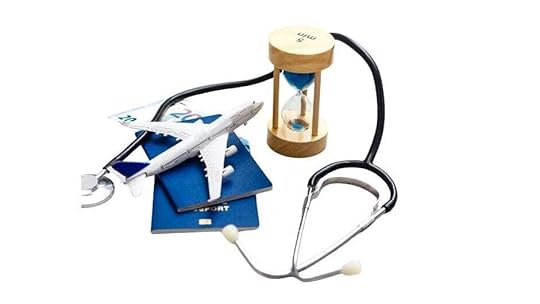
I do believe all our challenging situations so far have been down to luck rather than to anything else. But what about the next time? What if that time I had a toothache and went to see a dentist in South Korea had proven to be much more expensive?
What if the time I’d slipped on a wet footpath in Thailand and scraped the skin off my foot and had to go to the pharmacist had instead been a broken bone and a hospital admission?
What if that time we were in Central America and the backpacking husband was bitten by a mosquito and was feeling unwell had turned out to be Dengue Fever?
And, that excruciatingly painful time in Honduras, when I got stung by a scorpion – thankfully not a life-threateningly venomous type – but that might have been a lethally dangerous scorpion elsewhere.
From all my experience of travelling I certainly wouldn’t want to rely on luck alone.
I’d much rather know that my insurance policy had me fully covered for emergencies.

 Who are the best providers of Travel Insurance?
Who are the best providers of Travel Insurance?
My advice is to get a few no-obligation quotes so that you can compare travel insurance benefits and costs from all those travel insurance companies whom offer cover for those who are over 50 years old. Choose travel insurance companies that have a good standing in the industry, a good reputation, and lots of authentic and positive reviews from people who have had cause to make a claim.
Spending money on a travel insurance that doesn’t cover you for all the things you’ll need in an emergency situation abroad – is not only a terrible waste of your money – but also means you’ll have no safety net while travelling.
I know – it’s daunting and scary and a huge responsibility – but don’t panic!
Let’s take a look at what kind of cover we need for travel insurance in our 50’s, our 60’s, and older.
And, importantly, how to source such travel insurance and find out how much it costs.
See my personal recommendations below.
 What does Travel Insurance cost?
What does Travel Insurance cost?
GENKI TRAVEL INSURANCE: Recently, while I’ve been planning an extended trip to Asia for early in 2026, I’ve been looking at and been impressed with Genki Travel Insurance. They offer global cover for people from any country, travelling to any country.
With their ‘Genki Traveller’ policy they offer flexible health cover outside your home country for travel up to twelve months covering treatment for new illnesses and injuries and for hospitalisation and accidents and emergencies while travelling including medical transport and repatriation. They will cover you up to 69 years of age.
Designed for frequent and long term travellers, I like how the policy is paid in a flexible monthly subscription payments from one to twelve months. You can cancel your subscription anytime after the minimum coverage period of one month.
‘Genki also offer ‘Genki Native’ (with a choice of Basic and Premium Cover) for long term full cover health insurance policies for ex-pats and nomads with no fixed home address.
I highly recommend you click on the banner below to Learn More and get a no obligation quote from Genki to check cover and costs and monthly payments.
WORLD NOMADS TRAVEL INSURANCE: In the past I’ve taken out global travel policies with World Nomads (they cover for residents of 140 countries and offer some policies for people up to the age of 70). World Nomads are well established in covering long term travellers. I’ve been very happy with the cover they offered me while I was traveling extensively throughout the USA and Canada and Central America and while spending extended time travelling in South East Asia.
I recommend you click on their link to get a no-obligation quote from World Nomads to compare cover and costs.
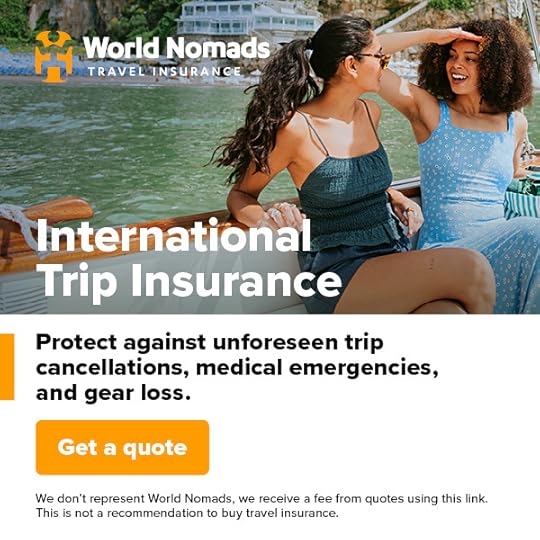
TRUE TRAVELLER INSURANCE: For UK and European residents. I’ve bought several travel policies from True Traveller Insurance in the past and they offer high cover insurance to people up to the age of 65 years old. They offer policies predominantly for adventurous activities and their strapline is ‘travel insurance designed by travellers’.
Again, it’s well worth getting a no-obligation quote from True Traveller.

FASTCOVER TRAVEL INSURANCE: For our Australian residents, I’ve also heard very good things about the extensive cover and extended age range (cover available up to 89 years of age) offered by multi-award winning Australian FastCover Travel Insurance who calculate your travel insurance policy on the age you purchased it and not the age you’ll be on your departure date or during your holiday.
I recommend – if you are from Australia – that you get a fast no-obligation quote from Fastcover Travel Insurance.
FastCover Travel Insurance is offering a 10% Discount Code for my readers. To claim your discount of 10% simply click link & enter code BACKPACK in ‘Apply a Voucher’ box on checkout page to apply coupon and get 10% OFF your Travel Insurance. Ends 31/12/25. * The *Applies to total undiscounted premium at checkout (Max 1 offer or discount can be used per policy). Underwritten by Certain underwriters at Lloyd’s. Consider PDS & TMD on fastcover.com.au. T&Cs apply.
 FastCover Travel Insurance
FastCover Travel Insurance
 The Backpacking Housewife at the dentist in South Korea
The Backpacking Housewife at the dentist in South Koreatravel insurance before you set off on your travels
Buying insurance at the same time you are booking your trip is a sensible option as you will be able to include cancellation insurance. With a home start and a return ticket and a trip lasting less than 90 or 120 days you will also have lots of options regarding the company you choose as your travel insurance provider.
Travel Insurance when you are already travelling
There are not so many travel insurance companies to choose from when you want to buy or renew your travel insurance while you are already travelling. As a referrer, the best global ones I have personally found are Genki and World Nomads.
How does travel insurance for over 50’s work?
It’s true that travel insurance for the over 50’s can be something of a major personal investment. We can do all we can to minimise risks while we travel. We can take advice. We can be cautious. We can get all our travel vaccines and be super careful.
BUT life is risky. Leaving home can be risky. We’ve all heard scary travel stories and accidents can and do happen when you least expect it and when you are least prepared.
For all these reasons – although I’ve read about older people advocating travel without insurance – claiming that medical care is an affordable out-of-pocket expense in lots of countries (in Asia, for example) but I personally believe it’s important to get the right insurance cover for the specific DESTINATIONS where you intend to travel.
What kind of travel insurance do you need?Your travel destination really matters, so verify that your policy provides adequate coverage based on your destination, especially for regions with political instability or higher healthcare costs.
To me, buying travel insurance always seems like a hassle and a chore because it’s time consuming. But, I still read through the policy carefully to study the fine print, so I’m absolutely clear in my understanding of what is covered and what is not covered.
It’s down to YOU to choose your policy responsibly and to buy the right travel insurance policy.
What IS covered and what is NOT covered?Buying a travel insurance policy can feel confusing and overwhelming and time consuming. But it’s really important to carefully read all the TERMS AND CONDITIONS and read THE SMALL PRINT and to be fully aware of what IS covered and what is NOT covered in the policy.
Travel insurance for over 50’s is often sold with a choice of different levels of cover. These levels of cover are often called something like Basic Cover for emergency medical insurance only, Premium Cover that will also cover you against any lost luggage and travel delays, and a Fully Comprehensive Cover that will cover you for most eventualities.
Some policies cover you for a single trip – a short vacation or cruise – and some offer ‘multi-trip’ options.
We discovered that most travel insurance companies require you to be in your country of residence during the time of purchase and they also require you to have a return ticket within the specified dates of the policy term.
But more recently, with the rise of digital nomad travel and in more people wanting to travel slowly and extensively and take much longer trips, insurance companies have realised there is a sizable – and lucrative – gap in the insurance market for Extended Trip and Nomad Insurance and travel insurance that you can renew while you’re still away from your home country.
Generally, you should always buy the policy that suits you best.
Check for age caps as some policies may state an upper age limit on cover.
Check for high coverage limits for medical expenses when traveling to countries where medical treatment is known to be expensive – like the USA, for example.
I can honestly say that I’ve never travelled without even the basic level of travel insurance.
Important Things TO NOTE When Choosing Travel InsuranceTravel Tip: Take a note of your travel insurance policy number and emergency contact number and keep it somewhere where you can find and access it in the case of an emergency. Also share this information, your travel itinerary, and a photocopy of your passport with your loved ones back home as a back-up.
Choose a reputable Insurance Company and do your research: Read recommendations and reviews and Trust Pilot is a great website for consumer reviews and the UK’s Money Saving Expert and Money Supermarket websites are also a good resource.
Do note that your home country can affect your choice of travel insurance company but there are travel insurance like Genki and World Nomads that don’t need you to have a home country as they offer a global service.
Decide on the type of travel insurance cover you needTravel Tip: If you are involved in an accident or incident however serious or minor then do keep any receipts and paperwork relating to what has happened to assist you in any travel insurance claim.
Do you want cover for any cancellations to your travel arrangements and for your cash and personal property? Especially important if you have high-value items with you while travelling. Or, do you only want cover for accident and medical emergency and repatriation should you need to come home quickly or if you die abroad?
We set out buying comprehensive annual multi-destination global travel policies that covered us for everything but after a while it made financial sense for us to think about choosing to buy MEDICAL INSURANCE ONLY to cover us in the event of personal injury, accidents, and any unexpected illnesses, rather than for flight delays, travel interruptions, cancellations or material losses.
This meant our belongings wouldn’t be covered for damage or loss – but as we learned to pack less and travel light and how to be travel savvy and because we don’t actually travel with anything particularly expensive – this was a compromise we were prepared to make for our travel insurance policy to be more affordable.
Except, there was one time when we’d only bought medical cover only insurance – rather than one covering any trip interruption cover – that we got the news of a close relative’s grave illness back home in the UK. Of course we had to fly home immediately – on the 2nd January – one of the busiest and most expensive times of the year and our travel insurance didn’t cover us for the cost of the extra travel.
On that occasion, we had to whip out our emergency credit card and accept the unforeseen costs. In hindsight, the incident did make us wish that we’d bought the extra insurance cover. We’d thought we were saving money but in the end it had backfired on us.
Single trip policies or annual policies?Work out which will be best for you depending on the region and the countries included in the policy and the additional benefits to buying an annual policy. I have found travel to (even transiting through) the United States of America is often an optional extra on policies and charged at a premium.
During my last trip to Central America, I managed overcome the additional expense of adding an overnight transit through the USA by buying an annual policy that allows for a set number of days in the USA as part of the policy at no extra cost.
PRE-EXISTING CONDITIONSDeclare all your pre-existing conditions and make sure the travel Insurance policy will cover emergency repatriation and check for Covid and any Covid related illness cover.
If you have travel insurance cover included through a credit card provider or a bank account are there any age restrictions to their cover?
Do you have to have actually purchased your travel with the card to qualify for travel insurance cover?
Does your card provider know about any pre-existing conditions, any prescription medications or any doctor or hospital appointments you’ve attended over the past few years?
If not, then you might NOT be as well covered as you think or not covered at all.
Understand ExclusionsUnderstanding these exclusions is crucial to avoid unexpected out-of-pocket expenses.
Carefully read the policy fine print and clarify exclusions with the insurer before purchasing coverage to avoid surprises during claims.
Exclusions in a travel insurance policy are specific circumstances, events, or conditions that are not covered by the policy. Common exclusions include:
Pre-Existing Medical Conditions: Some policies exclude coverage for medical conditions that existed before purchasing the policy unless explicitly declared and approved by the insurer.
High-Risk Activities: Adventure sports (e.g., skiing, scuba diving, or bungee jumping) or high-risk activities may be excluded unless covered under an additional policy rider.
Travel to Restricted or Dangerous Destinations: Destinations under travel advisories or war zones may be excluded. Insurers may deny claims if you travel to areas deemed unsafe by government authorities.
Self-Inflicted Injuries: Claims resulting from intentional self-harm, suicide attempts, or reckless behaviour are typically excluded.
Alcohol and Drug Use: Incidents occurring while under the influence of alcohol or drugs not prescribed by a doctor are generally not covered.
Negligence or Recklessness: Losses due to careless actions, such as leaving belongings unattended, may not be covered. Failure to follow safety guidelines (e.g., ignoring travel warnings) can void coverage.
Unapproved Medical Treatments: Medical expenses incurred for experimental treatments, cosmetic surgery, or procedures not deemed medically necessary are excluded.
Known Events: Policies usually exclude coverage for events that were already known at the time of purchase, such as a pre-announced natural disaster or strike.
Epidemics and Pandemics: Some policies exclude claims related to epidemics or pandemics although many insurers now offer specific coverage for these events.
Non-Travel-Related Incidents: Incidents unrelated to the trip, such as pre-existing legal obligations or personal disputes, are excluded.
Fraudulent Claims: Claims based on fraudulent information, misrepresentation, or deliberate acts to gain financial benefit are denied.
Acts of War or Terrorism: Injuries or losses caused by war, terrorism, or civil unrest are often excluded, though some policies may offer optional coverage for such risks.
Uninsured Events: Losses not explicitly covered in the policy, such as delays caused by airline bankruptcy or missed connections due to personal errors, are excluded.
Non-Compliant Behaviour: Failure to meet visa, passport, vaccination, or other legal travel requirements may void coverage.
TRAVEL INSURANCE FOR OVER 50’S ADVICE SUMMARYCompare Policies: Use the comparison websites I’ve recommended to you to get a no-obligation quote or use online brokers to evaluate coverage and costs.
Look for Discounts: Seek discounts through senior organizations, loyalty programs, or travel clubs. Use my EXCLUSIVE 10% Reader Discount Code for FastCover Travel Insurance.
Review Age Limits: Check for upper age restrictions on policies and consider senior-specific insurers if needed.
Declare Pre-Existing Medical Conditions: Be honest about your health history to avoid denied claims. Choose insurers that accommodate pre-existing conditions.
Focus on Comprehensive Medical Coverage: Ensure the policy covers emergency medical expenses, repatriation, and prescription medications. Look for high coverage limits, especially for travel to expensive healthcare destinations.
Evaluate Cancellation and Curtailment Cover: Opt for policies that protect against trip cancellations due to health or family emergencies.
Consider Activity Coverage: Ensure the policy includes coverage for activities you plan to engage in, like hiking or golf, or higher-risk activity coverage, like scuba diving, if necessary.
Check Policy Excesses: Look for policies with manageable excess fees to avoid large out-of-pocket expenses.
Understand the Claim Process: Ensure you understand how to file claims, what documentation is required, and the time frame for submissions. Look for insurers with good reviews for customer service and claim handling.
Check for Destination-Specific Needs: Ensure coverage aligns with your destination’s healthcare costs, political stability, and required documentation.
Read the Fine Print: Understand exclusions, coverage limits, and claim processes to avoid surprises.
ConclusionI do hope this guide on travel insurance has been helpful to you and has helped you to be travel savvy and to understand the importance of having the right travel insurance and how to go about finding it.
The insurance companies I have provided links for will provide you with no-obligation travel insurance quotes based on your age and your insurance cover requirements.
They are affiliate links because I have have chosen to partner and recommend them to you because I use them myself.
If you choose to request a no-obligation quote or to buy a policy through my link then I may receive a small commission at no extra charge to you and I will be grateful to you as it helps support this website.
Do leave a comment if you have any travel insurance stories to tell
Or information about travel insurance you’d like to share
Or recommendations you’d like to add that might help other travellers!

The post TRAVEL PLANNING: Travel Insurance for Over 50’s appeared first on The Backpacking Housewife.
June 5, 2025
Romania: Exploring Rural Romania
I believe the Romanian countryside offers something rare in today’s fast-paced world and that’s an unfiltered connection to tradition. Nestled among the rolling hills, vast pastures, and deep forests of Transylvania, Maramureș, Bucovina, and the Apuseni Mountains, I found the villages of rural Romania remain largely untouched by modern means.
During my time in Romania, I was staying with a dear friend who lives just outside Bucharest. And, having shown me around the capital city of Bucharest and taken me on guided tours to see fabulous palaces and gothic castles, she now wanted to show me her family home in the Romanian countryside.
Where, she says, the rhythm of life follows the seasons and her family’s age-old customs are not just remembered but are lived every single day.
I considered it a great privilege to experience this traditional Romanian way of life and now, my dear wanderful friends, I want to share this very special time in Romania with you with my words and photographs.
So, let’s take a journey – one that in many ways feels like traveling back in time – to explore an unfiltered life in the beautiful and unspoilt Romanian countryside.
 The beautiful and unspoilt Romanian countryside
The beautiful and unspoilt Romanian countrysideTABLE OF CONTENTS
WILD BEAUTY AND SIMPLE LIVING IN RURAL ROMANIACHEESE MAKING IN ROMANIAROMANIA’S APPLE ORCHARDSROMANY CULTUREHIKING IN THE CARPATHIANSROMANIA – STEP INTO A SLOWER WORLDBEAT THE RUSH TO ROMANIA!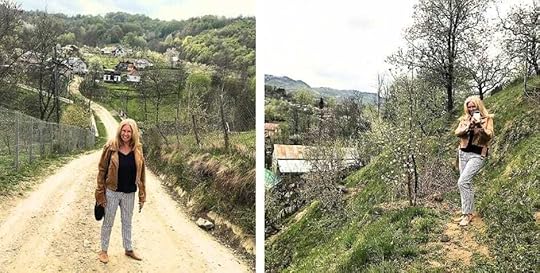 Enjoying life in the beautiful and unspoilt Romanian countryside
Enjoying life in the beautiful and unspoilt Romanian countrysideWhile driving through Romania’s Subcarpathian hills, I was unprepared for how eye wateringly beautiful it all is and I was amazed to see so many horse-drawn carts clopping on the roads, alongside cars and trucks.
I was also surprised discover that Romanian farmers still use traditional methods, passed down through generations, to tend to and to farm the land. Fields are ploughed with horse-drawn equipment and families work together from dawn until dusk. Self-sufficiency here is a way of life rather than a movement.
 Horse-drawn carts on the roads alongside all the cars and trucks
Horse-drawn carts on the roads alongside all the cars and trucksDuring my trip, thanks to the generosity of my friend and her family, I was invited to a fabulous traditional evening of Romanian music and dance and also to a big family gathering and a wonderful homecooked meal.
To respect the family’s privacy, I wont share those photos with you, however I DO have so many other photos to show you!
Perhaps one of the most iconic images of rural Romania is the sight of tall hand stacked haystacks – căpițe. This, I’m told, is more than just practical as it is a testament to a lifestyle rooted in respect for the land and its cycles and most village homes keep a few animals – cows, goats, chickens, and the hay sustains them through the harsh winters.
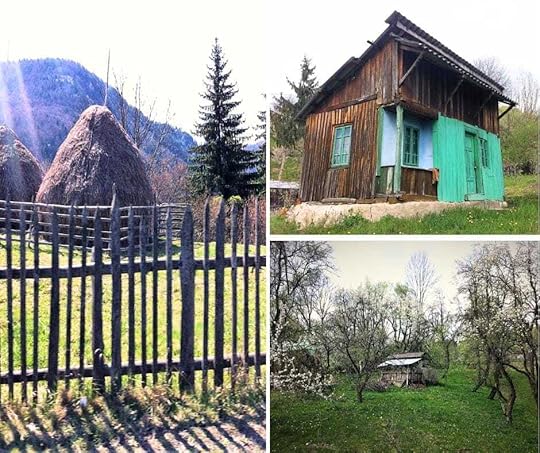
 Romanian farmers still use traditional methods passed through generations
Romanian farmers still use traditional methods passed through generationsOn our travels we stopped at the roadside where a farmer was sitting with his artisan cheese smoker and selling his fresh cheeses. I bought half a round of his cheese and later – after tasting the most delicious creamy smoky cheese I’ve ever had and that’s saying something as I’ve lived in France – I really regretted not buying the whole round. I’ll never ever forget that wonderful cheese or meeting the wonderfully interesting local man at that roadside stall in rural Romania!
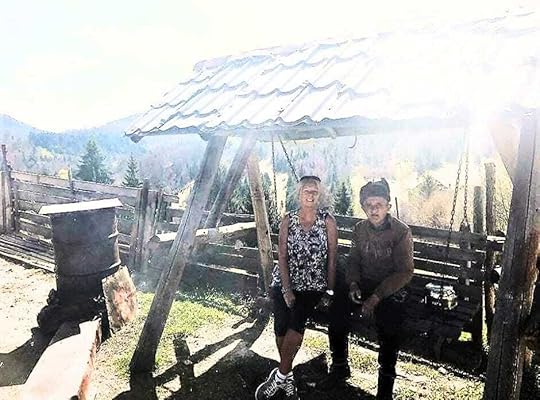 Meeting an artisan Romania farmer with his cheese smoker
CHEESE MAKING IN ROMANIA
Meeting an artisan Romania farmer with his cheese smoker
CHEESE MAKING IN ROMANIA
Cheese-making is an art in rural Romania, particularly in the shepherding regions of Transylvania and in places like Mărginimea Sibiului, where sheep and cow’s milk are transformed into delicacies such as telemea (a salty white cheese), caș, and urdă, often sold at village markets or roadside stalls (as I was lucky to find).
Everything is made by hand. There are no factories, no preservatives, just time, skill, and natural ingredients. In addition to dairy, villagers produce honey, smoked meats, jams, and pickles. Crops include potatoes, maize, sunflowers, cabbages, and beans. In some regions, you’ll even see small vineyards or patches of medicinal herbs.
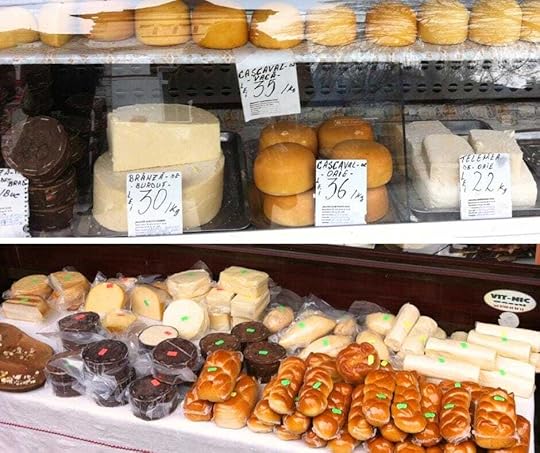 Cheese is sold at village markets or roadside stalls
ROMANIA’S APPLE ORCHARDS
Cheese is sold at village markets or roadside stalls
ROMANIA’S APPLE ORCHARDS
Romania’s Subcarpathian hills, particularly in the counties of Argeș, Bistrița-Năsăud, and Dâmbovița, are renowned for their apple orchards.
And this is where my Romanian friend’s family farm the land and have their apple orchards. I was there in the late springtime and so the remaining apples in storage – the staples in rural households – were left from the previous year’s harvest.
But, in the autumn time, I’m told the countryside becomes a patchwork of ripe fruit trees, their boughs heavy with apples of every variety. There are lots of fabulous festivals to celebrate the harvest and apple-based products from cider to compote.
Other fruits grown in abundance here include plums (used to make the traditional spirit țuică), cherries, pears, and berries – many of which grow wild in the forests.
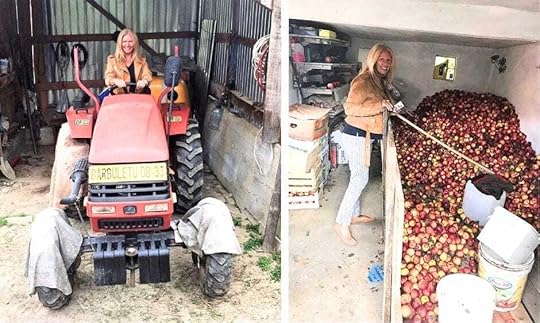
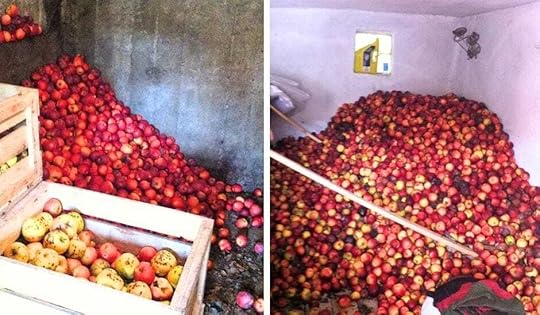 My Romanian friend’s family farm the land and have their apple orchards
ROMANY CULTURE
My Romanian friend’s family farm the land and have their apple orchards
ROMANY CULTURE
The Romany people (often referred to as Roma) are an integral yet complex part of Romania’s social fabric. Their presence in the countryside – with their horses and carts and vibrant freedom of spirit – I found both interesting and fascinating.
So much so that I captured the moment and took lots of photos as we came across them on the road.
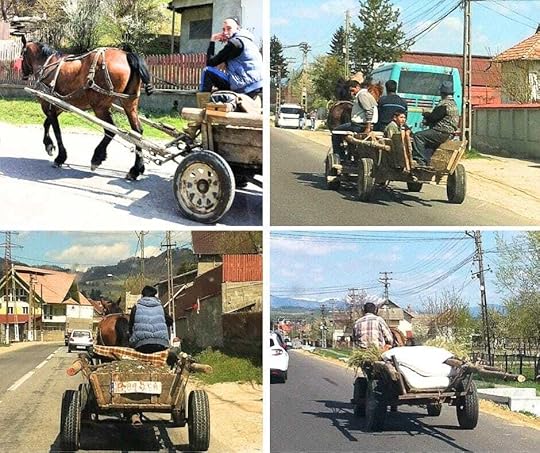
 Romany people (Roma) are an integral part of Romania’s social fabric
Romany people (Roma) are an integral part of Romania’s social fabricHistorically nomadic, many Roma communities have settled in rural areas, though I’m told that even here they often face social challenges and marginalisation. Despite these hardships, Romany traditions persist. Their resilience and culture offers a vital with their vivid clothing, large family gatherings, singing and storytelling.
 Romany horses and carts – and a vibrant freedom of spirit
HIKING IN THE CARPATHIANS
Romany horses and carts – and a vibrant freedom of spirit
HIKING IN THE CARPATHIANS
Romania’s natural beauty is breath taking and the Carpathian Mountains offer miles of hiking trails through dense forests, alpine meadows, and dramatic ridgelines.
Areas like the Retezat, Piatra Craiului, and Făgăraș Mountains are havens for nature lovers, offering solitude and panoramic vistas. But with this wilderness comes a challenge as Romania is home to Europe’s largest bear population outside of Russia.
It has been stated by the country’s forestry research institute that Romania may be home to as many as 13,000 brown bears, almost twice as many as previously thought.
A recent article in The Guardian newspaper says: “Bears have killed 26 people and severely injured 274 others over the past 20 years in Romania, the most recent fatality being a 19-year-old hiker who was mauled to death on a popular Carpathian trail last July.”
Hikers are therefore well advised to follow safety guidelines, carry bear spray, and respect nature’s boundaries. You have been warned!
 Romania’s natural beauty is breath taking
ROMANIA – STEP INTO A SLOWER WORLD
Romania’s natural beauty is breath taking
ROMANIA – STEP INTO A SLOWER WORLD
Have you ever seen haystacks built by hand, tasted cheese made the same way for generations, or walked where wild bears roam free?
Here in the Romanian countryside, time seems to stand still. From the apple orchards of Transylvania to the untouched trails of the Carpathians, travel to Romania and discover authentic village life, ancient farming traditions, and the vibrant culture of the Romany people.
This is Romania, unfiltered, and it’s breath taking!
 Romania, unfiltered, and it’s breath taking!
Romania, unfiltered, and it’s breath taking!BEAT THE RUSH TO ROMANIA!
Right now, Romania’s capital city of Bucharest is often overlooked by tourists looking for a city break in favour of its Western European counterparts. But, from this year on, Romania’s tourist industry is being predicted to grow exponentially.
In fact, Romania has just been featured as a stellar destination in Vogue’s Where To Travel In 2025.
This means that while Bucharest might be underrated and uncrowded right now and you’ll likely be beating the tourist masses to enjoy a more authentic Romanian experience – that might not be the case very soon – especially in response to the impact of over tourism in other places in Europe like Paris and Rome and Venice.
This makes Romania a great budget friendly European capital and top destination for travellers on a budget, with lots of low cost flights into (OTP) Bucharest Henri Coandă International Airport (Aeroportul Internațional Henri Coandă București).
Bucharest is still shifting politically, economically, and culturally. Romania became a member of NATO in 2004 and part of the European Union in 2007 but in January 2025 it became a Schengen Area member. With the removal of border controls, Romania is sure to see increased tourism and trade with other Schengen countries in the very near future, potentially driving up prices and speeding up economic growth.
Clearly, there has never been a better time than right now to visit Bucharest and the rest of Romania.
Do read my other posts on Romania – click on the boxes below – for a fabulous Romanian travel itinerary!

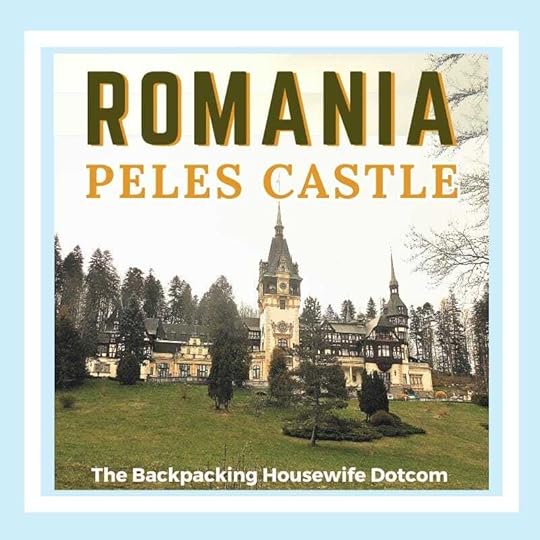

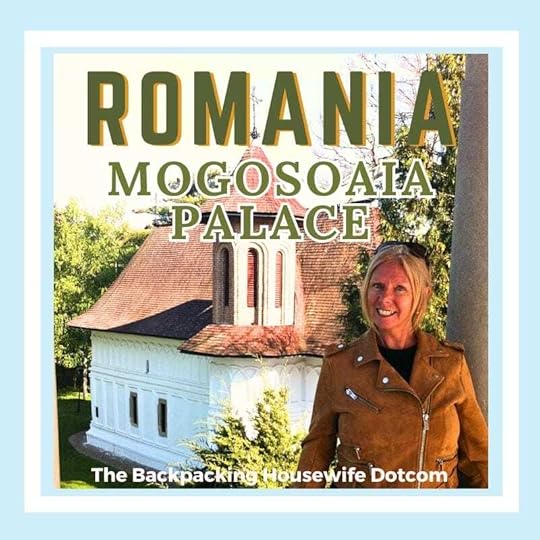
The post Romania: Exploring Rural Romania appeared first on The Backpacking Housewife.
June 3, 2025
Romania: Bran Castle
While I was visiting Romania, I was extremely excited to take a day trip from Bucharest to explore and experience Bran Castle – often called Dracula’s Castle – one of the most iconic landmarks in Romania.
Nestled in a picturesque valley near the Carpathian Mountains, on the border of Transylvania and Wallachia and close to the town of Brasov, Bran Castle it is about 160km (100 miles) or a two-and-a-half-hour drive from the Romanian capital Bucharest.
I loved visiting old castles (see Peles Castle) and ancient palaces (see Mogosoaia Palace) while in Romania but I have to admit to feeling particularly fascinated by the famous Bran Castle legend that associates it with Count Dracula!
Built in 1377 on a rocky outcrop that gives the castle a dramatic, spooky, and almost fantasy-like presence, it has a dramatic history, and deep ties to myth and legend.
And, even though I was aware that the association with Dracula and Bran Castle and Vlad the Impaler (the historical figure behind Bram Stoker’s Dracula story) is only tenuous at best, I was far too wrapped up in the glorious and gory gothic tale to be distracted by a historical reality check!
Travel with me to Transylvania and let’s explore Bran Castle and the Dracula connection!
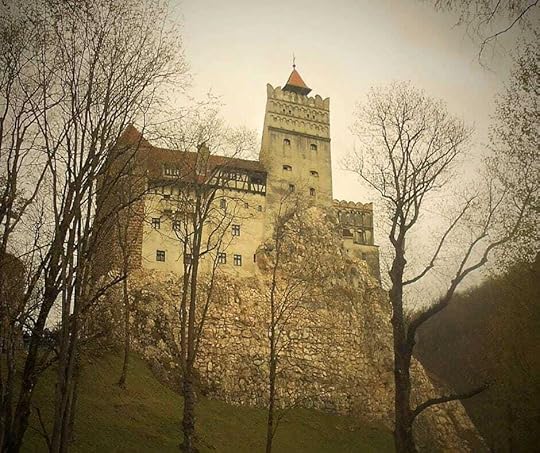 Bran Castle Transylvania Romania: Photo Copyright – Janice Horton
Bran Castle Transylvania Romania: Photo Copyright – Janice HortonTABLE OF CONTENTS
BRAN CASTLE ROMANIAVLAD THE IMPALER (VLAD III DRACULA)VLAD’S TORTURE EXHIBITION AT BRAN CASTLEBRAM STOKER’S RESEARCH FOR DRACULAGOTHIC HORROR IN WHITBY ENGLANDHOW TO VISIT BRAN CASTLEBEAT THE RUSH TO ROMANIA! BRAN CASTLE ROMANIA
BRAN CASTLE ROMANIA
Construction began on Bran Castle in the 14th Century after King Louis I of Hungary granted the Saxons of Kronstadt (Brasov) the right to build a stone fortress on a site identified as having a strategic location for defending the mountain pass between Transylvania and Wallachia.
As you can see from my atmospheric photo above – the castle has steep towers, narrow staircases, and stone walls that give it a gothic appearance that’s perfect for fuelling vampire legends!
 From Bran Castle’s leaded tower windows there are panoramic views
From Bran Castle’s leaded tower windows there are panoramic viewsInside, there are round fifty-seven rooms, many small and interconnected, creating a labyrinthine of secret passageways. There’s also a hidden staircase, discovered during renovations in the 1920s, that connects the first and third floors and believed to have been used in times of siege for a quick escape.
From the leaded tower windows there are panoramic views of Moeciu Valley and the Bucegi Mountains. The inner courtyard is surrounded by balconies and arched corridors and although in an authentically ruined state there is a beautiful stone well.
 The inner courtyard is surrounded by balconies and arched corridors
The inner courtyard is surrounded by balconies and arched corridors Bran Castle – often called Dracula’s Castle – one of the most iconic landmarks in Romania
Bran Castle – often called Dracula’s Castle – one of the most iconic landmarks in Romania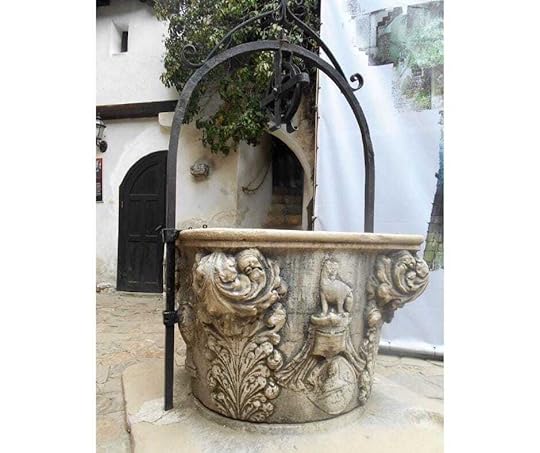 Inside Bran Castle courtyard there is a beautiful stone well
Inside Bran Castle courtyard there is a beautiful stone wellThe castle also features exhibits on the historical figure who inspired Bram Stoker’s Dracula – Vlad the Impaler – along with medieval weapons, armour, and displays of his gruesome impalement methods (his signature punishment).
As Vlad’s nickname ‘Tepes’ literally means ‘The Impaler‘ in Romanian.
 Vlad’s nickname ‘Tepes’ literally means ‘The Impaler’
VLAD THE IMPALER (VLAD III DRACULA)
Vlad’s nickname ‘Tepes’ literally means ‘The Impaler’
VLAD THE IMPALER (VLAD III DRACULA)
Vlad the Impaler notoriously executed enemies by impalement – a method where victims were skewered on long wooden stakes and left to die slowly.
Legend says he would sometimes dine among the impaled corpses, further fuelling his monstrous reputation. One of the most infamous stories comes from the Ottoman Sultan Mehmed II’s invasion of Wallachia in 1462 regarding the ‘The Forest of the Impaled’. When the Sultan entered Vlad’s forest, he found over 20,000 impaled corpses and thought it a war tactic so disturbing that it caused the invading army to retreat.
Some writings from the 15th century (German and Slavic sources) claimed Vlad dipped his bread in the blood of his victims which heavily influenced the later vampire mythos.
But in Romania, Vlad is seen more as a national hero than a bloodthirsty villain because he defended Wallachia from Ottoman conquest, protected peasants from noble exploitation, and is remembered for his uncompromising justice.
History also suggests that Vlad was likely killed in battle against the Ottomans around 1476. His head was reportedly cut off and sent to the Sultan in Constantinople as proof of death. The resting place of his body is still debated as no confirmed grave had been found. But some claims suggesting the Snagov Monastery near Bucharest where, during renovations, a headless body in royal attire was discovered, although it’s still debated as to whether it’s Vlad’s.
Klook.com (function (d, sc, u) { var s = d.createElement(sc), p = d.getElementsByTagName(sc)[0]; s.type = "text/javascript"; s.async = true; s.src = u; p.parentNode.insertBefore(s, p); })( document, "script", "https://affiliate.klook.com/widget/fe..." ); VLAD’S TORTURE EXHIBITION AT BRAN CASTLELocated in the castle’s basement or annex area, the torture chamber exhibit is a popular (and gruesome) addition to the museum. While it’s not part of the original medieval function of the castle it complements the ‘Dracula lore’ and reflects the authentic European torturous practices from the Middle Ages to the early modern era.
The Iron Maiden: A tall coffin-like sarcophagus lined with inward-facing spikes on which victims would be closed inside and then slowly impaled.
 A tall coffin-like sarcophagus lined with inward-facing spikes!
A tall coffin-like sarcophagus lined with inward-facing spikes! The Rack: Victim’s limbs were tied at each end of a wooden frame and stretched via a turning wheel. Commonly used during Inquisitions to extract confessions.
The Spanish Boot: Iron or wooden device clamped to the legs, then tightened or driven with wedges. It caused extreme crushing injuries.
The Heretic’s Fork: A metal rod with sharp ends placed between the chin and chest or the throat and breastbone to prevent movement. Often used on those accused of heresy.
The Catherine Wheel: Victims were tied to a large wheel and beaten or left to die and then often displayed publicly as a warning to others.
Thumbscrews, Branding Irons, Masks of Shame: Smaller tools used for public humiliation or interrogation. Masks of shame were iron or leather masks meant to ridicule and silence gossipers or heretics.
 The torture chamber exhibit is a popular (and gruesome) addition to the museumKlook.com (function (d, sc, u) { var s = d.createElement(sc), p = d.getElementsByTagName(sc)[0]; s.type = "text/javascript"; s.async = true; s.src = u; p.parentNode.insertBefore(s, p); })( document, "script", "https://affiliate.klook.com/widget/fe..." );
BRAM STOKER’S RESEARCH FOR DRACULA
The torture chamber exhibit is a popular (and gruesome) addition to the museumKlook.com (function (d, sc, u) { var s = d.createElement(sc), p = d.getElementsByTagName(sc)[0]; s.type = "text/javascript"; s.async = true; s.src = u; p.parentNode.insertBefore(s, p); })( document, "script", "https://affiliate.klook.com/widget/fe..." );
BRAM STOKER’S RESEARCH FOR DRACULA
Bran Castle draws hundreds of thousands of visitors yearly, especially when themed events are offered, yet Dracula’s author, Bram Stoker, (1847–1912) was an Irish writer, deeply interested in the supernatural, gothic literature, and folklore.
He worked for decades as the manager of the Lyceum Theatre in London, where he met intellectuals, actors, and travellers from around the world. He had a strong analytical mind, doing extensive research on Transylvanian history, vampire legends, and Eastern European culture despite never visiting Romania.
Indeed, it is said that the fictional castle in his gothic tale was inspired by both his imagination and from an etched drawing of a misty mountain fortresses that he’d seen in an old book while researching for his novel.
As Stoker was writing in the age of the Victorian Gothic revival, his literary influences included Emily Gerard’s essay called ‘Transylvanian Superstitions‘ (1885) which described Romanian beliefs in the strigoi and nosferatu.
He was also influenced by the works of Mary Shelley’s Frankenstein (1818), Sheridan Le Fanu’s Carmilla (1872), and Edgar Allan Poe’s Tales of Horror.
As Bran Castle strongly resembles the setting richly described in Dracula it was adopted in the 1970s by the Romanian tourism board as “Dracula’s Castle” and the myth stuck.
Interestingly, Bram Stoker’s original notes and his research for Dracula was discovered in the 1970s in a barn in Pennsylvania. These handwritten notes are now archived at the Rosenbach Museum in Philadelphia.
They reveal just how methodical and creative he was with records and timelines for all the main characters – especially the complex movements of Dracula, Harker, Van Helsing, etc, and of his long lists of Transylvanian superstitions – some are supposed to be real – and some are invented by him!
Early character name ideas were “Count Wampyr” (before he became Dracula). Wilhelmina” for Mina, which he kept, and “Van Helsing” was originally “Max Warkeli”
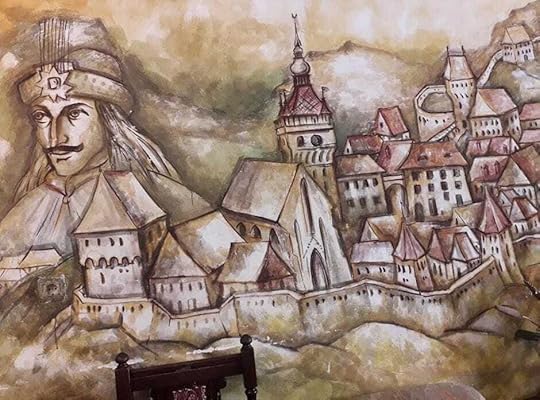 Stoker was writing in the age of the Victorian Gothic revival
GOTHIC HORROR IN WHITBY ENGLAND
Stoker was writing in the age of the Victorian Gothic revival
GOTHIC HORROR IN WHITBY ENGLAND
It’s thought that Bram Stoker may have chosen the name “Dracula” after reading about Vlad the Impaler (Vlad Tepes), a 15th-century ruler of Wallachia, in William Wilkinson’s 1820 book An Account of the Principalities of Wallachia and Moldavia, which he found in the local library in Whitby, England, which fuelled his inspiration for the gothic horror in his writing.
Bram Stoker stayed in Whitby in July of 1890, lodging at Mrs Veazey’s guesthouse at 6 Royal Crescent, and exploring the town and its surrounding landscape.
It seems the town’s dramatic ruins, like Whitby Abbey, and its dark history and its notorious association with shipwrecks, all provided inspiration for his novel’s gothic atmospheric setting.
From reading European folklore about undead beings who rise from the grave to drink blood or torment the living he then created supernatural traits for his vampire. He can’t go cross running water. He must sleep in native soil. He is repelled by sunlight, garlic, crucifixes, mirrors, and wooden stakes. He can change form into bat, wolf, or mist. Many of these are now recognised as vampire lore.
Here he also discovered that “Dracula” is a Romanian term that translates to “son of the dragon” but over time – as drac can also mean “devil” – it came to mean “son of the devil” which, of course, only added to the aura of superstition and medieval fear.
So, despite never stepping foot in Romania, Bram Stoker has shaped the world’s image of Transylvania and Dracula remains the most iconic vampire story ever written!
 Dracula remains the most iconic vampire story ever written!Klook.com (function (d, sc, u) { var s = d.createElement(sc), p = d.getElementsByTagName(sc)[0]; s.type = "text/javascript"; s.async = true; s.src = u; p.parentNode.insertBefore(s, p); })( document, "script", "https://affiliate.klook.com/widget/fe..." );
HOW TO VISIT BRAN CASTLE
Dracula remains the most iconic vampire story ever written!Klook.com (function (d, sc, u) { var s = d.createElement(sc), p = d.getElementsByTagName(sc)[0]; s.type = "text/javascript"; s.async = true; s.src = u; p.parentNode.insertBefore(s, p); })( document, "script", "https://affiliate.klook.com/widget/fe..." );
HOW TO VISIT BRAN CASTLE
You can visit Bran castle independently and drive to Bran Castle or you can take public transport using a bus or train and bus.
Drive from Bucharest – Take route DN1/E60 160km. Driving time approx. 2.5 hours driving time.
Drive from Brasov – Take route DN73/E574 30km. Driving time approx 35 minutes.
By Train/Bus: You can take the train from Bucharest to Brasov and then a bus or take a taxi to Bran Castle.
By Train from Bucharest to Brasov via Romanian Railways (CFR). Bucharest Nord Gara A. Hourly. (See Timetable). Distance is 170km and travel time approx. 3.5 hours
From Brasov you can then transfer to bus service or pick-up a local taxi service. For the bus – at terminal No. 2 in Brasov – the bus between Brasov and Bran departs every 30 minutes and every hour on weekends. Look for buses marked Brasov – Bran.
For more information on visiting times and special events go to the official Bran Castle Website. You can buy your tickets online and in advance (recommended) or on arrival at Bran Castle. Over 65’s get a discount on the ticket price (show ID).
Perhaps a more relaxing way to get there – and to make the most of a day trip from Bucharest – would be to take a guided tour. Guided tours often include visits to Brasov Old Town and other interesting old castles and palaces in the area.
I hope you’ve enjoyed my tour of Bran Castle and I hope you also want to read my other posts from my trip to Romania.
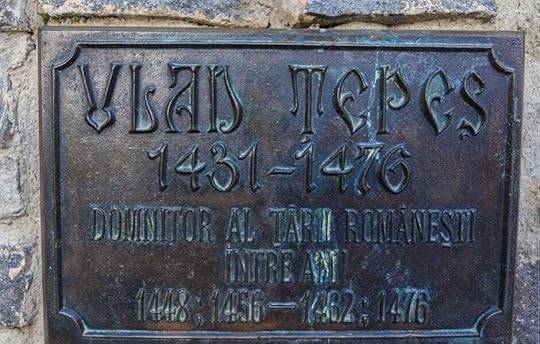 Vlad The Impaler 1431-1476
BEAT THE RUSH TO ROMANIA!
Vlad The Impaler 1431-1476
BEAT THE RUSH TO ROMANIA!
Right now, Romania’s capital city of Bucharest is often overlooked by tourists looking for a city break in favour of its Western European counterparts. But, from this year on, Romania’s tourist industry is being predicted to grow exponentially.
In fact, Romania has just been featured as a stellar destination in Vogue’s Where To Travel In 2025.
This means that while Bucharest might be underrated and uncrowded right now and you’ll likely be beating the tourist masses to enjoy a more authentic Romanian experience – that might not be the case very soon – especially in response to the impact of over tourism in other places in Europe like Paris and Rome and Venice.
This makes Romania a great budget friendly European capital and top destination for travellers on a budget, with lots of low cost flights into (OTP) Bucharest Henri Coandă International Airport (Aeroportul Internațional Henri Coandă București).
Bucharest is still shifting politically, economically, and culturally. Romania became a member of NATO in 2004 and part of the European Union in 2007 but in January 2025 it became a Schengen Area member. With the removal of border controls, Romania is sure to see increased tourism and trade with other Schengen countries in the very near future, potentially driving up prices and speeding up economic growth.
Clearly, there has never been a better time than right now to visit Bucharest and the rest of Romania!
WHERE TO STAY NEAR TO BRAN CASTLE
CLICK HERE TO FIND YOUR PERFECT PLACE TO STAY IN BUCHAREST VIA MY POST ON BUCHAREST
FIND YOUR PERFECT PLACE TO STAY NEAR TO BRAN CASTLE AND BRASOV USING THIS MAP
The post Romania: Bran Castle appeared first on The Backpacking Housewife.
May 10, 2025
Romania: Mogosoaia Palace
Mogosoaia Palace has been standing for centuries just a few miles outside of Bucharest, Romania’s capital city, and yet has somehow managed to stay off the radar of many international travellers to Romania. Wandering around its walls and grounds, it feels to me like you’re exploring a time capsule, with beautiful remnants of history where the past is preserved in stone, glass, and silence, amidst old trees, lake waters, and manicured gardens.
If you’re traveling to or from Bucharest, Mogosoaia Palace is a must see on your itinerary. It is a spectacular slice of Romanian history wrapped in Brâncovenesc architecture, art, and political drama.
Like many of Romania’s castles and citadels that look like they belong in a fairy tale or a gothic novel – Mogosoaia Palace is not just a pretty building – it was born of ambition and tragedy and is now a monument to resilience, vision, and the cost of leadership.
Built between 1698 and 1702 by Constantin Brâncoveanu, one of Romania’s most influential historical figures, the palace was intended as a lavish retreat for his family. However, history took a cruel turn. In 1714, Brâncoveanu was captured by the Ottoman Empire, accused of treason, and executed along with his four sons in Constantinople.
After Brâncoveanu’s execution the palace was confiscated but it survived and was later returning to family hands and eventually became a museum. But I feel this tragic story lends an emotional depth to the site. Whether you’re a history buff, an architecture nerd, or simply someone looking to stroll around and relax in nature there’s something here for you.
So, let’s travel back in time together, to find out what makes Mogosoaia Palace more than just a beautiful photo opportunity.
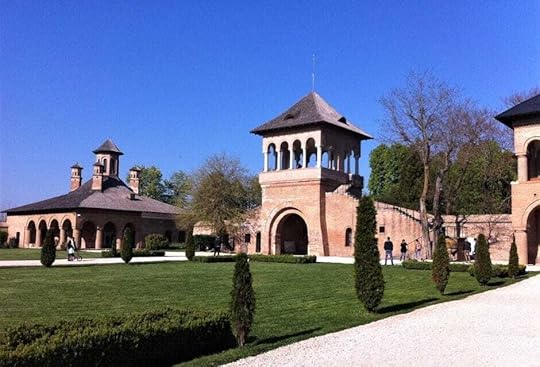 Mogosoaia Palace Bucharest Romania is more than just a beautiful photo opportunity
Mogosoaia Palace Bucharest Romania is more than just a beautiful photo opportunityTABLE OF CONTENTS
MOGOSOAIA PALACETHE BRÂNCOVENESC ARCHITECTURAL STYLEMOGOSOAIA FROM RUIN TO REVIVALTHE CHURCH OF ST. GEORGETHINGS TO SEE AND DO AT MOGOSOAIA PALACEMOGOSOAIA PALACE TIMELINEGETTING THERE – PLAN YOUR TRIP Mogosoaia Palace is a must see addition to your Bucharest itinerary
THE BRÂNCOVENESC ARCHITECTURAL STYLE
Mogosoaia Palace is a must see addition to your Bucharest itinerary
THE BRÂNCOVENESC ARCHITECTURAL STYLE
One of the most striking features of Mogosoaia Palace is its architectural style, known as Brâncovenesc. If you’ve never heard of it, don’t worry, because once you see it – you’ll wonder why it hasn’t achieved global fame as Romania’s own Renaissance.
Imagine carved stone balconies, intricate arches, and richly decorated façades, all with a subtle Eastern influence. Mogoșoaia Palace is often cited as the finest surviving example of this style and seeing it in person is a visual feast.
As I wandered through the palace’s airy galleries and arched corridors, I kept stopping to admire the detailing and the way light filtered through the carved stone. Every angle seemed designed for quiet contemplation and admiration.
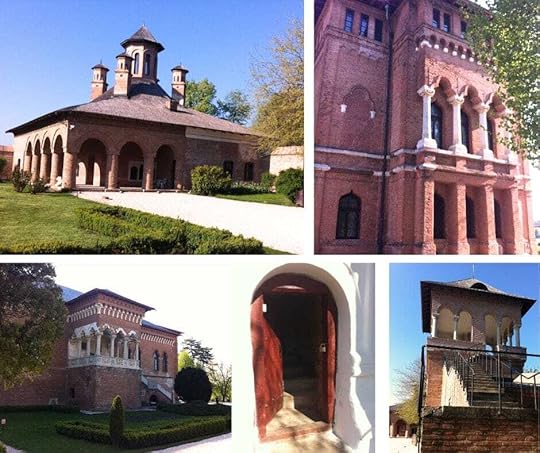 Imagine carved stone balconies, intricate arches, and richly decorated façades, all with a subtle Eastern influence
MOGOSOAIA FROM RUIN TO REVIVAL
Imagine carved stone balconies, intricate arches, and richly decorated façades, all with a subtle Eastern influence
MOGOSOAIA FROM RUIN TO REVIVAL
Like many old European landmarks, Mogosoaia Palace has seen its share of decline and rebirth. It encapsulates the Romanian spirit in a way that’s elegant yet understated, tragic yet hopeful. After Brâncoveanu’s execution, the palace passed through various hands and suffered damage during several historical upheavals – including the Russo Turkish wars and both World Wars.
It wasn’t until the early 20th century that the palace found a saviour in Martha Bibescu, a Romanian-French aristocrat, writer, and socialite. Married into the Bibescu family, which had acquired the estate, she turned Mogoșoaia into a centre of culture, hosting European intellectuals and royals.
Under her watchful eye, the palace was lovingly restored, and many of its decorative elements—such as frescoes and woodwork – were revived or rebuilt. Walking through its rooms today, you’ll see both original and restored elements, thoughtfully preserved to reflect the palace’s layered history.
The central hall, now used for exhibitions, still exudes aristocratic charm. And when you step out into the Italian-style gardens or down to the lake, it’s easy to imagine elegant guests strolling these grounds a century ago and feel a quiet connection to the people who had once walked these grounds: princes, poets, martyrs, and travellers.
Places like Mogosoaia Palace Bucharest Romania remind us that history is not just something you read in books – it’s something you feel in your bones when you stand in the right place.
 Places like Mogosoaia remind us that history is not just something you read in books
THE CHURCH OF ST. GEORGE
Places like Mogosoaia remind us that history is not just something you read in books
THE CHURCH OF ST. GEORGE
Before we go any further though, if you’ve read my posts enthusing over the Temples of Chiang Mai in Thailand or Angkor Wat and the Archaeological Park in Cambodia, you’ll know I love the architecture and feeling of spirituality in old temples and churches. So I want to share with you my own favourite discovery amongst the many buildings that make up the Mogosoaia Palace.
That discovery is The Church of St. George (Biserica Sfântul Gheorghe) which predates the palace by more than a decade. It was built in 1688 by Prince Constantin Brâncoveanu and was decorated with frescos in 1705.
This timeline is significant as it reveals Brâncoveanu’s deep commitment to Orthodox Christianity and highlights how religious devotion often preceded and justified noble construction projects in the 17th Century.
It was common in that era, for rulers to begin major estates with the erection of a church or monastery, both as an act of piety and as a symbol of divine blessing upon their ambitions. In this way, the Church of St. George was not just a private chapel, but a spiritual cornerstone for the palace to be built.
The church is a classic example of Brâncovenesc architecture, similar to the palace but expressed on a more intimate scale. Despite its small size and its layout typical of Orthodox churches, the church feels harmonious and noble, almost like a spiritual twin to the larger residence nearby.
Inside, the church contains fabulous original frescoes from the 17th century (many of them restored) depicting scenes from the life of Christ and the Virgin Mary and the Orthodox saints, including St. George, the church’s patron.
 Inside the church contains fabulous original frescoes from the 17th century
Inside the church contains fabulous original frescoes from the 17th century 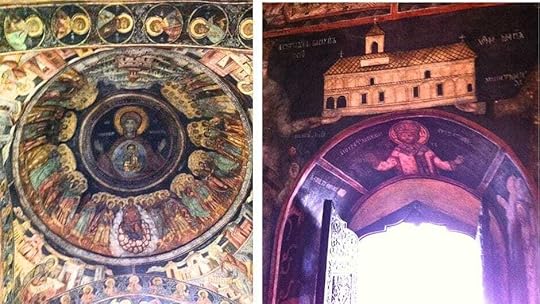 Elegant columns and arches combining Byzantine, Ottoman, and Western European influences
Elegant columns and arches combining Byzantine, Ottoman, and Western European influencesI was in awe of the ornately carved stonework and richly decorated entrance with exquisitely detailed motifs in what felt like a serene and spiritual space. Elegant columns and arches combining Byzantine, Ottoman, and Western European influences.
Portraits featuring Constantin Brâncoveanu and his family, highlight their religious devotion – but what certainly adds emotional power to the space – is the knowledge that Brâncoveanu and his sons, canonized as martyrs by the Romanian Orthodox Church, were executed for refusing to convert to Islam.
Their portraits inside the church now serve as a form of reverence and remembrance. It’s a powerful experience to stand in a church they once prayed in and where their memory is still honoured.
The church is surrounded by a quiet, leafy churchyard, often now used for weddings, christenings, and local festivals. It provides a serene transition between the formal elegance of the palace and the spiritual gravity of the church, which still functions as an active place of worship, especially on religious holidays, providing insight into Romania’s living Orthodox traditions.
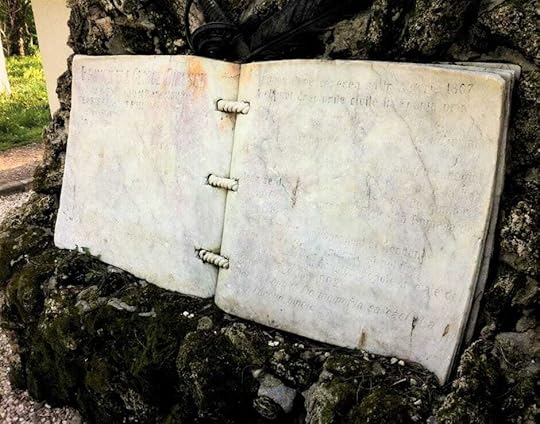

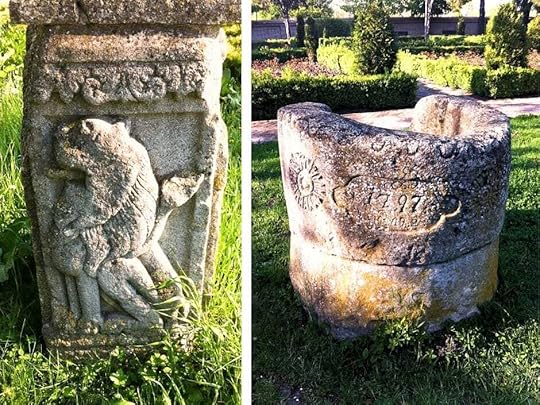
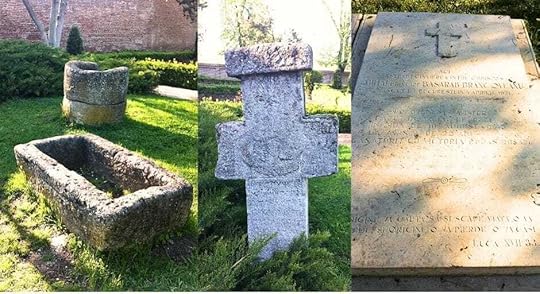 The church of St George at Mogosoaia Palace is surrounded by a peaceful leafy churchyard
THINGS TO SEE AND DO AT MOGOSOAIA PALACE
The church of St George at Mogosoaia Palace is surrounded by a peaceful leafy churchyard
THINGS TO SEE AND DO AT MOGOSOAIA PALACE
1. The Palace Museum: The former living quarters now house the Mogosoaia Palace Museum, part of the Bucharest Museums network. Inside, you’ll find period furniture, original frescoes, decorative arts, and rotating art exhibitions. There’s an especially fascinating section on Brâncoveanu’s life, complete with documents and artifacts that bring his story vividly to life.
2. The Venetian-style Loggia: One of the most photogenic spots is the upper-floor loggia overlooking the lake. This open balcony, with its ornate columns and balustrade, is ideal for taking in the spectacular scenery.
3. Strolls and Picnics in the Grounds: I spent over an hour simply wandering the grounds. The palace is nestled within a spacious park, complete with walking paths, open lawns, and quiet groves.
5. The Art and Culture Scene: Depending on when you visit, you might find a classical music concert, art exhibition, or even a craft fair taking place. Mogosoaia Palace often hosts cultural events, especially in the warmer months. Check local listings or the palace’s official page for schedules.
 The former living quarters now house the Mogosoaia Palace Museum
MOGOSOAIA PALACE Bucharest Romania TIMELINE
The former living quarters now house the Mogosoaia Palace Museum
MOGOSOAIA PALACE Bucharest Romania TIMELINE
St George Church was erected by Constantin Brancoveanu in 1688 and was decorated with frescos in 1705.
The Watch Tower was raised before 1702 and restored in 1930 and 1980.
The Cuhnia (Brancovan Kitchen) was built in the period 1681-1702 and its ventilation furnaces were restored in 1965.
The Palace was finished by Constantin Brancoveanu in 1702 and offered as a gift to his son Stefan, was wholly restored by Martha and George Valentin Bibescu in the period 1812 – 1927.
The Guest House was erected by Nicolae G Bibescu in 1870 on the site of the 17th Century manor and was rebuilt by architect George Matei Cantacuzino in the period 1922 – 1930.
The Ice House, in summer, before 1900 they used to store perishables under reed lumps of ice from Mogosoaia Lake, the original construction was restored in 1960.
The Glass House ordered by Nicolae G Bibescu in 1890 was restored in 2002.
 GETTING THERE – PLAN YOUR TRIP
GETTING THERE – PLAN YOUR TRIP
So when you’re in Bucharest I recommend you take the tour and the detour. Follow the winding roads through Romania’s countryside and when you arrive at the gates of Mogosoaia – take a breath – because you’re stepping into a time capsule!
Mogosoaia Palace is about 16 km or approximately (20-30 minutes by car or taxi) from central Bucharest. You can also reach it by public transport. Take bus 460 or a train to Buftea and then it’s just a short walk.
Location: Situated just 16 kms outside of Bucharest so it’s an easy day trip.
Guided Tours: I recommend you make a day of it and Take a Small Group Tour for a deeper understanding of the palace’s history. If you only have a half day to explore then this private half day tour takes in Mogosoaia Palace and also Snagov Monastery where Vlad The Impaler (of Dracula fame) is said to be buried.
Getting There: You can travel independently by car, bus, taxi, or get picked up and dropped off at your hotel by a private tour guide.
Photography: Capture the beauty of the palace but be mindful of any restrictions inside.
What to Bring: Comfortable shoes, especially if you want to explore the park. A camera is a must. Snacks or a picnic blanket can turn your visit into a daylong outing.
Best Time to Visit: Late springtime through to early autumn offers the most pleasant weather and blooming gardens. Autumn brings rich colours, and the palace is less crowded.
WHERE TO STAY IN BUCHAREST ROMANIAWhile staying in Bucharest, I took a day trip to Mogosoaia Palace and while in Romania I mostly stayed with a friend but for my first night and for last few days, I stayed at the iconic Grand Hotel in University Square, which is in a great location and within walking distance from the Old Town.
Built in 1967, The Grand Hotel (previously it was The Intercontinental) is the tallest hotel in Bucharest and so it is also a city landmark and located right next to the National Theatre. From my room, the panoramic views of the city and those overlooking University Square and the busy Balcescu Boulevard were mesmerising.
FIND YOUR PERFECT PLACE TO STAY IN BUCHAREST USING THIS INTERACTIVE MAP
Have you explored Romania yet?
Have you been to Mogoșoaia Palace?
Let me know in the comments!
THE BACKPACKING HOUSEWIFE RECOMMENDS TRAVEL INSURANCE
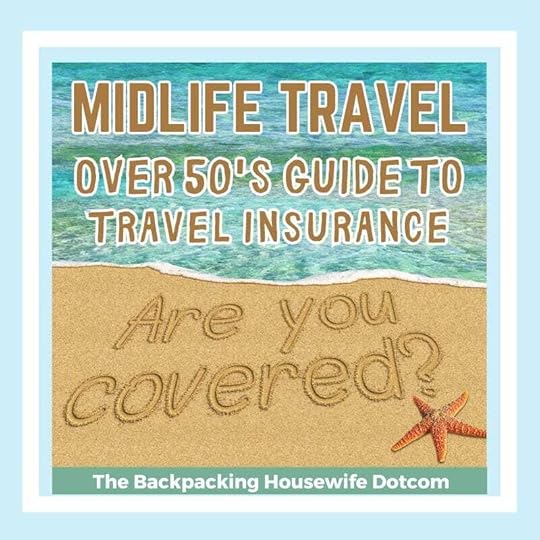
The post Romania: Mogosoaia Palace appeared first on The Backpacking Housewife.
May 7, 2025
Romania: Peles Castle
Peles Castle is tucked away in the town of Sinaia, high up in Romania’s Carpathian Mountains in Romania, and is considered one of the most beautiful castles in Europe. It’s an architectural gem that looks like it leapt right out of a fairy tale – or perhaps a gothic novel – where mist clings to its towers and to the treetops and legends seem to echo off every statue and stone wall.
But, Peles Castle, Romania’s royal summer retreat, isn’t just another pretty palace with ornate chandeliers and lavish halls. This place whispers secrets. There’s hidden passageways and jaw-dropping details (like a royal library with a secret door and an elevator built in the 1800s).
There’s mysterious symbols engraved into the panelling and tales of foreign emperors and kings, queens, and even Orient Express passengers, who once strolled here under its steep spires and stained glass ceilings where today it’s said that many wandering ghostly spirits have been seen.
So, how do you start to explore a place like this? Well, you don’t just walk through its halls – you time travel.
Romania has both inspired me and caught me by surprise and so this isn’t just a travel guide. In this post, we’re diving into a story-rich itinerary, and I’m inviting you to travel with me from Bucharest and to join me in exploring Romania’s most breath taking, bizarre, and romantic castle!
 Peles Castle looks like it’s right out of a fairy tale or perhaps a gothic novel
Peles Castle looks like it’s right out of a fairy tale or perhaps a gothic novelTABLE OF CONTENTS
Peles Castle RomaniaPELES CASTLESinaia travel guideFIND YOUR PERFECT PLACE TO STAY IN SINAIA CLOSE TO PELES CASTLERoyal Castles, Hidden Monasteries & Mountain MagicITINERARY – HOW TO SPEND A Day in SinaiaWhispers from Peles: Romania’s Most Enchanted CastlePlan Your Visit to peles castlePELES CASTLE OPENING HOURS AND VISITING SCHEDULE Peles Castle Gate and Gardens
Peles Castle Gate and Gardens Peles Castle Gatehouse
Peles Castle Gatehouse
A NOTE ABOUT PHOTOGRAPHY: While you can photograph outside Peles Castle for free there’s a fee in addition to the regular entrance fee to take pictures inside the castle. Upon payment you can then take photos but for personal use only and without a flash. Publishing them online (including on social media) is strictly prohibited. So you’ll see that some of the photos I’ve used to illustrate inside the castle in this post are sourced from Wiki Commons and I have credited them as such.
PELES CASTLECommissioned by Romania’s first king – King Carol I – in 1873 and officially finished a decade later, Peles Castle is a jaw-dropping mix of German Renaissance flair, Italian elegance, and a sprinkle of eclectic European charm.
Inside there’s one hundred and sixty rooms decked out with Murano glass chandeliers, hand-painted ceilings, rich Cordoba leather walls, stained-glass windows from Germany, and rare woods and furniture from all across Europe and even India.
But Peles wasn’t designed just to look pretty – it was futuristic – because we’re talking hot and cold running water, central heating, telephones, a mini elevator, even a vacuum system a long time before that was ever a thing.
It was also the first castle in Europe powered entirely by electricity thanks to the waters of the nearby Peles stream powering a hydro plant used to produce all the electricity needed for the castle.!
Each room is its very own masterpiece. Imagine lounging in the Turkish Salon, where handmade silk embroideries adorn the ceiling and walls, or flipping through books in the Royal Library that houses 30,000 books and has a secret door that leads to king’s suite.
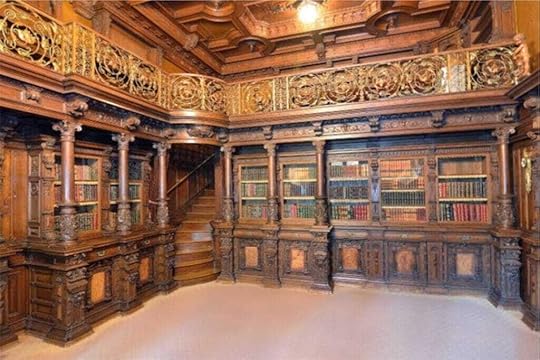 Carol I of Romania
,
CC BY-SA 4.0
, via Wikimedia Commons
Carol I of Romania
,
CC BY-SA 4.0
, via Wikimedia Commons Ștefan Jurcă from Munich, Germany
,
CC BY 2.0
, via Wikimedia Commons
Ștefan Jurcă from Munich, Germany
,
CC BY 2.0
, via Wikimedia CommonsFurniture in the Music Room is carved of teak, a gift to King Carol I from the Maharajah of Kapurtala in India.
King Carol I was an avid collector of armoury and his collection numbered over 4,500 weapons dating from the 15th to the 19th centuries are on display at Peles armoury. The pièce de résistance being a knight and (his) horse armour that weights 265 lbs.
 DeMaris
,
CC BY 3.0
, via Wikimedia Commons
DeMaris
,
CC BY 3.0
, via Wikimedia Commons © Antoine FLEURY-GOBERT / Wikimedia Commons
© Antoine FLEURY-GOBERT / Wikimedia CommonsThe castle even has its own 60-seat theatre that features Louis XIV French classicism style and where Romania’s first film was screened in 1906. The theatre’s elaborately painted ceiling and the decorative frieze is by Austrian painters Gustav Klimt and Frantz Matsch.
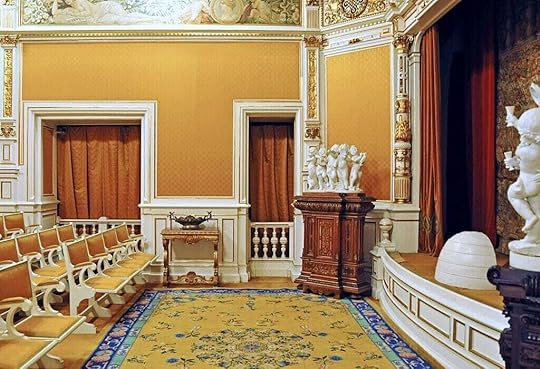 Dennis G. Jarvis
,
CC BY-SA 2.0
, via Wikimedia Commons
Dennis G. Jarvis
,
CC BY-SA 2.0
, via Wikimedia Commons Carol I of Romania
,
CC BY-SA 4.0
, via Wikimedia Commons
Carol I of Romania
,
CC BY-SA 4.0
, via Wikimedia CommonsIn my opinion the pièce de résistance and ultimate symbol of status here has to be the stunningly spectacular Honour Hall, which has a sliding stained-glass ceiling, so that guest could look up at the stars. It is said to have cost 1.5 million lei (gold) which would be approximately 18 million US Dollars today!
 Carol I of Romania
,
CC BY-SA 4.0
, via Wikimedia Commons
Carol I of Romania
,
CC BY-SA 4.0
, via Wikimedia Commons Carol I of Romania
,
CC BY-SA 4.0
, via Wikimedia Commons
Carol I of Romania
,
CC BY-SA 4.0
, via Wikimedia CommonsBefore Peles Castle even existed, Sinaia’s royal roots started at the Sinaia Monastery, founded in 1695. The royal family stayed there during their mountain retreats until Peles was completed. Today, the monastery still stands as a peaceful stop, surrounded by forest and alpine beauty.
Over the years, Peleș has hosted kings, queens, emperors, and even an early batch of Orient Express passengers.
Henri Blowitz, The Times Paris correspondent and passenger on the Orient Express Paris to Istanbul, 1883 maiden voyage, said “I have never seen a castle like this before. Wood, marble, glass, interwoven, intertwined, fabulous, ingenious, imaginative. In between towers that scratch the sky like swords.”
In 1896 – Franz Joseph I – Emperor of Austria, a friend of the Romanian Royal Family, visits Peles Castle. Shortly after his visit to Peles, the emperor wrote in a letter: “The Royal Castle – amongst other monuments – is surrounded by extremely pretty landscape with gardens built on terraces, all at the edge of dense forests. The castle itself is very impressive through the riches it has accumulated: old and new canvases, old furniture, weapons, all sort of curious, everything placed with good taste. We took a long hike in the mountains, afterwards we picnicked on the green grass, surrounded by the Gypsy music. We took many pictures, and the atmosphere was extremely pleasant.“
Even under communist rule, the castle was treated like a VIP guesthouse—hosting global figures like Nixon and Gaddafi. It closed for a while during that era, but post-1990, it’s been restored and reopened to the public. In 2006, the Romanian government handed it back to the royal family, who now lease it as a museum.
 Even under communist rule the castle was treated like a VIP guesthouse
Even under communist rule the castle was treated like a VIP guesthouseSo, if you’re planning to explore Romania, make space on your itinerary for Sinaia and see my suggested trip itinerary.
Whether you’re into history, architecture, mountain vibes, haunted castles in Romania, or just want to live out your fairy tale castle fantasies, a day at Peles Castle is a must!
And if Peles has whet your appetite for other castles near Bucharest, there are so many more enchanting castles and historic palaces to see and so much to do and explore in the surrounding area, that you may wish to extend your stay in Sinaia to allow more time to explore all the nearby landmarks.
If so, then you might like to book into one of the many fabulous hotels, lodges, or guesthouses.
 Henri Blowitz – The Times Paris correspondent “I have never seen a castle like this before”.
Sinaia travel guide
Henri Blowitz – The Times Paris correspondent “I have never seen a castle like this before”.
Sinaia travel guide
As well as Peles Castle in the Sinaia area, there is also Cantacuzino Castle as well as Stirbey Castle and Pelisor Castle and Foișor Castle and George Enescu Memorial House and also Sinaia Monastery, to explore, and a little further away is Brasov Old Town and Transylvania and Bram Castle of Dracula fame!
If you want to stay in a historic building then Vila Camelia is in a prime location. It was constructed by one of the architects of the Peles Palace in 1884 and shares its Bavarian influences with ornate decoration and characteristic wood fittings.
The Royal Residence is a historic villa located in the historic centre of Sinaia. Dating from 1901, it was once the Insurance House of the Royal Crown, and now offers aparthotel-style accommodations with private bathrooms, balconies, and views of landmarks.
 Furniture in the Music Room is carved of teak from India
FIND YOUR PERFECT PLACE TO STAY IN SINAIA CLOSE TO PELES CASTLE
Royal Castles, Hidden Monasteries & Mountain Magic
Furniture in the Music Room is carved of teak from India
FIND YOUR PERFECT PLACE TO STAY IN SINAIA CLOSE TO PELES CASTLE
Royal Castles, Hidden Monasteries & Mountain Magic
You can easily take a day trip from Bucharest to visit Peles Castle – the crown jewel of Romanian royal history – and to explore the surrounding area of Sinaia, Romania.
Check for the current visitor schedule and opening times at the official Pele Castle Website.
Do note that (at the time of writing in 2025) Peles castle is closed on a Monday and a Tuesday.
The distance and travel time from Bucharest is around 80 miles. While you’re in Bucharest do see my itinerary and what to do in Bucharest post. It’s easy to book a guided day trip with Get Your Guide or, alternatively, you can rent a car and drive yourself. This is my suggested itinerary:
ITINERARY – HOW TO SPEND A Day in Sinaia9:00 AM – Arrive in Sinaia & Grab Breakfast in Town: Start your day early and arrive in Sinaia with the mountain air still crisp. Head to one of the local cafés near the train station—Caramello or La Strada are great picks—for a strong Romanian coffee and a fresh pastry. Fuel up, because you’re about to step into a real-life fairytale.
10:00 AM – Explore Peleș Castle Grounds: Head up the tree-lined path to the Royal Domain. The first glimpse of Peleș Castle through the forest is unforgettable—it’s like walking into a movie set. The gardens are manicured, the mountain backdrop is epic, and the architecture is next-level ornate. TIP: Get your photos early before the crowds roll in.
10:30 AM – Tour Inside Peleș Castle: Book a guided tour and wander through room after room of royal opulence: The Hall of Honour with its retractable stained-glass ceiling. A mini-theatre where Romania’s first movie was shown in 1906. The Royal Library with a hidden door behind the bookshelves. The Turkish Salon, Moorish Hall, Music Room, and Armoury each have its own theme, story, and treasure trove of details. Optional: Audio guides are available and worth using.
12:00 PM – Pop Over to Pelisor Castle: Just a short stroll from Peleș is its quirky little sister, Pelisor Castle. This was the personal residence of Queen Marie (a total style icon), and it’s full of art nouveau vibes, golden accents, Tiffany glass, and personal touches that make it feel more like a home than a palace.
1:00 PM – Lunch at the Foișor or Casa cu Farfurii: Walk down to the quaint Foișor area and have lunch at a local spot like Casa cu Farfurii, set in a rustic villa with hearty Romanian dishes. Try the sarmale (cabbage rolls) or ciorbă de burtă (tripe soup)—Romanian comfort food at its best.
2:30 PM – Stroll to Sinaia Monastery: After lunch, take a short walk to the Sinaia Monastery. This peaceful religious complex, built in 1695, is where the royal family stayed before Peleș was completed. The monastery is still active and beautifully preserved, offering a serene contrast to the opulence of the castles.
3:30 PM – Optional Nature Walk or Cable Car Ride: If you’re still feeling energetic, take a hike into the Bucegi Mountains or hop on the Gondola Sinaia for panoramic views of the valley. This area is packed with nature trails, perfect for hiking, rock climbing, or simply admiring the wild Carpathian scenery. TIP: Even an easy trail like the Piatra Arsă route offers stunning views with minimal effort.
5:00 PM – Coffee Break & Wrap-Up: Head back into town and treat yourself to a warm drink and dessert at Taverna Sârbului or Kalimtzakis. Reflect on a day well spent walking in the footsteps of royals and soaking up mountain magic.
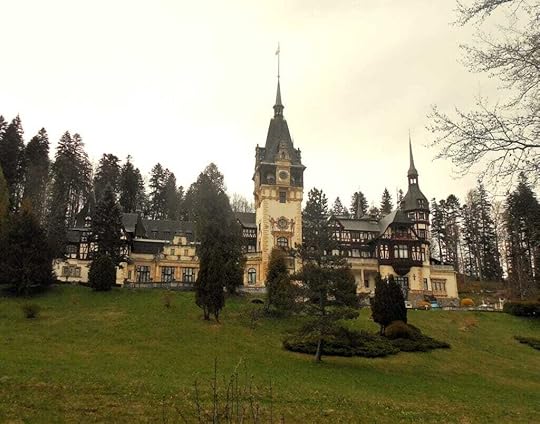 Peles Castle Romania: Photo by Janice Horton
Whispers from Peles: Romania’s Most Enchanted Castle
Peles Castle Romania: Photo by Janice Horton
Whispers from Peles: Romania’s Most Enchanted Castle
Peles Castle Ghost Stories: Is Peles Castle Haunted? Well, I feel there’s certainly something disturbing about about Peles Castle because behind the glitter of Murano chandeliers and the opulence of the hand-carved wood panels, you get the feeling that Peleș hides secrets. Strange ones, romantic ones, even a little eerie.
Maybe it’s the strange Romanian folklore or the fairy tale turrets slicing into the Carpathian sky? Or maybe it’s the echo of royal footsteps across marble floors? Or, it’s the Carpathian mountain myths, the legends, and the spooky stories that they don’t tell you on the official tour?
The Queen Who Never Left: Queen Elisabeth of Wied was many things: a poet, a dreamer, and Romania’s first queen. But some say she’s also the castle’s most loyal ghost. Guards have heard faint humming from the Music Room after midnight. Doors close gently on their own. And once, a security camera caught a hazy figure moving through the Great Hall – then vanishing into thin air. She loved the castle so much… maybe she never really left?
The Library Door That Disappears: In the Royal Library lies a hidden passage – a secret door disguised as a bookshelf. It opens to the King’s private suite… and it locks behind you without a trace. It was meant for privacy. But one rumour tells of a noblewoman who entered during an argument and was never seen again. No record, no goodbye – just gone. Test your courage: knock once on the shelf. Just once.
The Guest Who Triggered a War: In 1914, Archduke Franz Ferdinand walked these gardens, admiring Romania’s royal summer retreat. He joked with King Carol, sipped coffee under ivy-draped balconies, then left for Sarajevo. Weeks later, he was assassinated, and World War I erupted. The night he left, a freak thunderstorm split the sky above the Carpathians. Some swear it was a warning. The castle knew what was coming.
The Room That Didn’t Want to Be Built: Originally, it was supposed to be a sunroom. But everything went wrong. Tools vanished, workers got sick, and the light refused to shine. So, the architects gave up and built the now infamous Moorish Room instead. But guests report cold drafts, moving shadows, and a distinct sense that something is watching from the walls. Legend says the room still resents its creation – and wants out.
The Heart Queen’s Love That Couldn’t Be: Queen Marie—icon, artist, romantic—was married to King Ferdinand. But her heart? It belonged to Barbu Știrbey, a nobleman and her secret lover. Some claim their love still lingers near Pelișor Castle, just uphill from Peleș. Locals report two shadows often appear on the balcony together—even when no one is inside. Her body rests elsewhere. But her heart was buried in a chapel nearby – close to him.
The Hall of 2,000 Eyes: The Honor Hall is a marvel of carved wood and grandeur. But if you look closely… it’s full of faces. Over 2,000 of them: saints, monsters, kings, and warriors. Visitors swear they follow your gaze. One artist tried to sketch them all during a late-night tour. But the next morning, he discovered a new face had appeared on the wall – his own. He never came back.
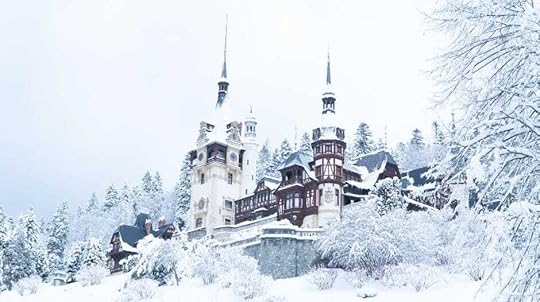 Peles Castle Romania is considered one of the most beautiful castles in EuropePlan Your Visit to peles castle
Peles Castle Romania is considered one of the most beautiful castles in EuropePlan Your Visit to peles castlePeleș Castle isn’t just a place—it’s a story still being told. Whether you believe the legends or just love a good tale, one thing’s for sure – you’ll leave with goosebumps, questions, and a craving to return. Ready to explore the legends for yourself?
Here’s what you need to know:
Tickets: Available on-site or through official Peles Castle site.
Location: Sinaia, Romania – 1.5 hr train ride from Bucharest. 80 miles / approximately a 2 hour drive.
If you want to leave the driving to someone else (I much prefer to do this) then why not take a Group Tour to Pele Castle From Bucharest or a Small Group Tour or take a Private Tour to include Pele Castle, other castles, and the surrounding area.
PELES CASTLE OPENING HOURS AND VISITING SCHEDULEMonday – Tuesday: Closed
Wednesday: 10:00 – 17:00
Thursday – Sunday: 09:15- 17:00
Individual visits: Last entry/individual visit is at 4:00 PM. The last guided tour forms at 3:15 PM.
The last tickets for Peleș Castle on sale at 3:45 PM. Students benefit from free admission during school holidays.
From Wednesday to Sunday, guided tours in Romanian and English will be organized according to the following schedule:
Wednesday: 10:30 AM ,11:30 AM, 12:30 PM, 1:30 PM, 2:30 PM, 3:30 PM
Thursday – Sunday: 09:45 AM, 10:45, 11:45 AM, 12:45 PM, 1:45 PM, 2:45 PM, 3:15 PM
Do you enjoy European Holidays?
Have you visited Romania yet?
Let me know – leave a comment.
Tell me if this post has been helpful?
The post Romania: Peles Castle appeared first on The Backpacking Housewife.
May 5, 2025
Romania: Bucharest
Right now, Romania’s capital city of Bucharest is often overlooked by tourists looking for a city break in favour of its Western European counterparts. But, from this year on, Romania’s tourist industry is being predicted to grow exponentially.
In fact, Romania has just been featured as a stellar destination in Vogue’s Where To Travel In 2025.
This means that while Bucharest might be underrated and uncrowded right now and you’ll likely be beating the tourist masses to enjoy a more authentic Romanian experience – that might not be the case very soon – especially in response to the impact of over tourism in other places in Europe like Paris and Rome and Venice.
This makes Romania a great budget friendly European capital and top destination for travellers on a budget, with lots of low cost flights into (OTP) Bucharest Henri Coandă International Airport (Aeroportul Internațional Henri Coandă București).
Bucharest is still shifting politically, economically, and culturally. Romania became a member of NATO in 2004 and part of the European Union in 2007 but in January 2025 it became a Schengen member. With the removal of border controls, Romania is sure to see increased tourism and trade with other Schengen countries in the very near future, potentially driving up prices and speeding up economic growth.
Clearly, there has never been a better time than right now to visit Bucharest and the rest of Romania. So grab your camera, charge your phone, and let’s go and spend three days in Bucharest.
Let’s lose ourselves in the streets of a city steeped in a rich history and where its wide boulevards and Belle Epoque buildings offer a charm that’s hard to resist.
Why go to Paris France when you can go to the Paris of the East?
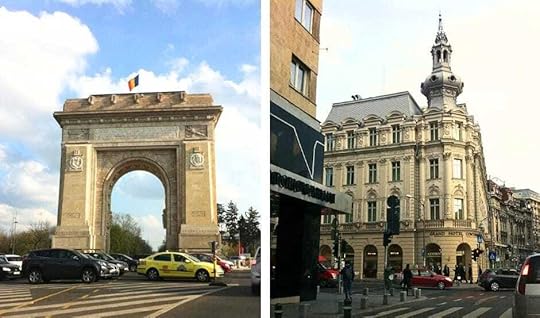 Paris of the East with its own Arc de Triumph and Belle Epoque buildings
Paris of the East with its own Arc de Triumph and Belle Epoque buildingsTABLE OF CONTENTS
BUCHAREST – PARIS OF THE EASTBUCHAREST – CITY OF HISTORY AND BOHEMIAN CHARMWHERE TO STAY IN BUCHAREST ROMANIABUCHAREST INFLUENCES AND HISTORYLITTLE PARIS OF THE EASTTHE PALACE OF THE PARLIAMENTBUCHAREST TODAYBUCHAREST ART SCENEBUCHAREST CAFE CULTUREMY THREE DAY ITINERARY FOR BUCHARESTDay 1: The Heart of Bucharest – History, Architecture & Old Town VibesDay 2: Parks, Museums, and Romanian CultureDay 3: Local Life, Hidden Gems & Day TripsSEE MY BUCHAREST THREE DAY ITINERARY ON GOOGLE MAPSMY TOP TIPS FOR BUCHARESTLEARN A FEW PHRASES IN ROMANIANWHEN IS THE BEST TIME TO VISIT BUCHAREST ROMANIA? BUCHAREST – CITY OF HISTORY AND BOHEMIAN CHARM
BUCHAREST – CITY OF HISTORY AND BOHEMIAN CHARM
Bucharest is an unexpectedly fascinating city. I say unexpectedly because, although this was my first visit to Romania, I hadn’t done any of my usual pre-trip research and planning. I’d literally arrived in Bucharest with absolutely no expectations whatsoever, except to catch up with some of my lovely Romanian friends, whom I’d previously met in Thailand.
And my first impressions after flying into Bucharest was of eye-popping wonder.
I always enjoy a city with a rich history and interesting culture, and I honestly didn’t know which way to turn or which building to stare at first or next, on my ride from the airport into the city centre.
Medieval churches, communist-era apartment blocks, and sleek modern skyscrapers all stood proudly together and then we drove past a huge Arc de Triumph and the eye-popping soon became jaw-dropping.
Who knew that this (until recently) considered off the beaten path destination was so rich in culture, mystery, and architectural marvels? Clearly there are so many things to do in Bucharest.
My dear Romanian friends soon educated me on how from its humble beginnings as a medieval fortress to its transformation into a Belle Epoque metropolis and subsequent reshaping under communism, every era in Bucharest’s history had left a fingerprint here.
If you are wondering if you can ‘do’ Bucharest as a weekend city break then the answer is – YES and you absolutely should – but spending three days exploring this fascinating city would be the ideal. See my three-day top sightseeing itinerary below.
But if you can stay for longer than two or three days then you could also get out of the city and into the Romanian Countryside to discover elaborate Romanian Palaces and to head into Transylvania to explore Bram Castle of Dracula fame!
Travel with me to Bucharest in Romania and let me introduce you to one of Eastern Europe’s most underrated gems – often dubbed the ‘Paris of the East’ – a city where history, rebellion, and bohemian charm, come together in perfect and sometimes chaotic harmony.
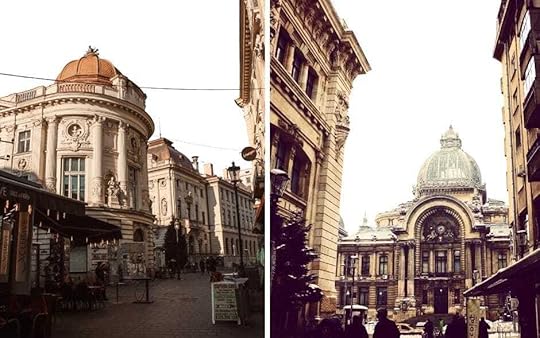
 Photos I took from the car having just arrived in Bucharest
WHERE TO STAY IN BUCHAREST ROMANIA
Photos I took from the car having just arrived in Bucharest
WHERE TO STAY IN BUCHAREST ROMANIA
In Romania I mostly stayed with a friend but for my first night and last few days, I stayed at the iconic Grand Hotel in University Square, within walking distance from the Old Town.
Built in 1967, The Grand Hotel (previously it was The Intercontinental) is the tallest hotel in Bucharest and so it is also a city landmark and located right next to the National Theatre. From my room, the panoramic views of the city and those overlooking the busy Balcescu Boulevard were mesmerising.
Interestingly, during the Romanian Revolution of 1989, the hotel became the base for the foreign press as the vantage point from the balconies provided a perfect view of the protests in University Square.
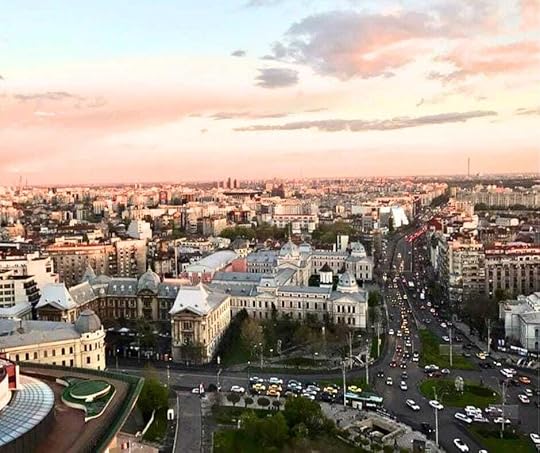 From my room – panoramic views of the city
From my room – panoramic views of the city FIND YOUR PERFECT PLACE TO STAY USING THIS INTERACTIVE BUCHAREST MAP
BUCHAREST INFLUENCES AND HISTORYOur cultural appreciation of Bucharest begins back in the 14th century and the medieval period. The Old Princely Court (Curtea Veche) is the oldest monument in Bucharest was built as a palace residence by Vlad Țepeș (Vlad the Impaler aka the blood sucking inspiration for Bram Stoker’s Dracula story!) Take the tour!
Then there’s the city’s Brâncovenesc style early religious churches like the decorative Stavropoleos Monastery, built by a Greek monk in 1724, with its intricate wood carvings and serene courtyard with Romanian Orthodox influences. What makes this small church unique is that it houses a library of over eight thousand books on theology, byzantine music, (the largest collection in Romania) plus arts and history.
The late 19th and early 20th centuries were a period of significant transformation for Bucharest as the influence of French architecture is undeniable here with many buildings mirroring Parisian designs that have earned this city the nickname of ‘Little Paris’ or ‘Paris of The East’.
This era saw the rise of neoclassical and Art Nouveau styles, evident in iconic buildings such as the National Bank of Romania, the Romanian Athenaeum with its elaborate facade and opulent interior, and the CEC Palace, with its distinctive glass dome.
 The Romanian Athenaeum in Bucharest
LITTLE PARIS OF THE EAST
The Romanian Athenaeum in Bucharest
LITTLE PARIS OF THE EAST
Many of Bucharest’s broad boulevards, like Calea Victoriei, and its grand buildings, such as the Central University Library, the CEC Palace, and the Palace of Justice, were designed or inspired by French architects or Romanian architects educated in Paris.
This is the reason for the Belle Epoque style seen in Bucharest’s palazzos, concert halls, and cafes, which was popular in Paris during this period and includes ornate facades and elegant designs in the Neoclassical and Art Nouveau influence.
Romania’s own Arc de Triumph or Arcul de Triumf stands as a landmark in the northern part of Bucharest and was built in 1935 to commemorate Romania’s victory in the First World War.
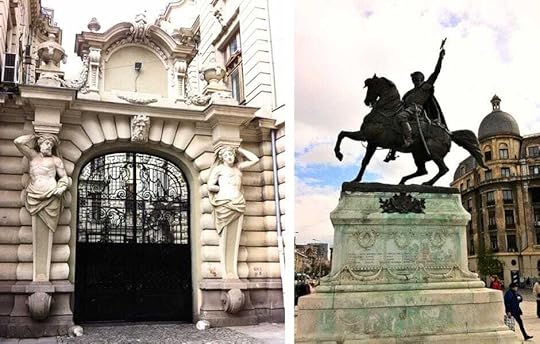
 In Bucharest buildings were designed by French architects or Romanian architects educated in Paris.
THE PALACE OF THE PARLIAMENT
In Bucharest buildings were designed by French architects or Romanian architects educated in Paris.
THE PALACE OF THE PARLIAMENT
The communist regime (1947-1989) left an enduring mark on Bucharest’s architectural landscape. Imposing structures – its grandeur reflecting the desire to project power and control – such as the colossal Palace of the Parliament (formerly known as the House of the People) stands today as an opulent and controversial symbol of the era.
The Palace of the Parliament, commissioned by Nicolae Ceaușescu, and built while much of Romania was struggling economically is said to be the heaviest building in the world and the second largest administrative buildings – second only to The Pentagon in Washington USA. Top tip: Book a tour in advance.
 The colossal Palace of the Parliament in Bucharest
BUCHAREST TODAY
The colossal Palace of the Parliament in Bucharest
BUCHAREST TODAY
Today, wandering around the old streets of Bucharest, offers a unique opportunity to witness the evolution of architectural styles and to understand the cultural and historical influences that have shaped the city because the buildings tell a story of resilience, ambition, and transformation. I highly recommend a City Highlights Walking Tour and if you prefer a one to one guided experience you can book a Private Walking Tour and Guide and if you’d prefer to experience The Best of Bucharest with a fun ride then check out A Private TukTuk Tour!
Vintage markets and antique shops are delightfully tucked into side streets, offering everything from Soviet-era memorabilia to Romanian ceramics. I also enjoyed shopping in the modern malls and in the high street ‘names’ the prices were so low compared to elsewhere in Europe and so, loving a bargain, I bought several new outfits including a jacket and shoes!
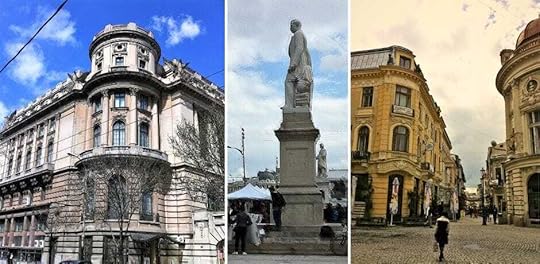 Vintage markets and antique shops are delightfully tucked into side streets
Vintage markets and antique shops are delightfully tucked into side streetsIf you happen to need a break from the city buzz and a brief respite between cultural activities, you should know that Bucharest also has lots of tranquil botanical gardens and grassy parks with trees and lakes and fabulous water features, in which to relax.
Why not live like a local and take a picnic or a book to relax in Cismigiu Park (also known as Central Park) or to Herastrau Park next to the Arch of Triumph which also offers open-air cafés and boat rides on the lake?
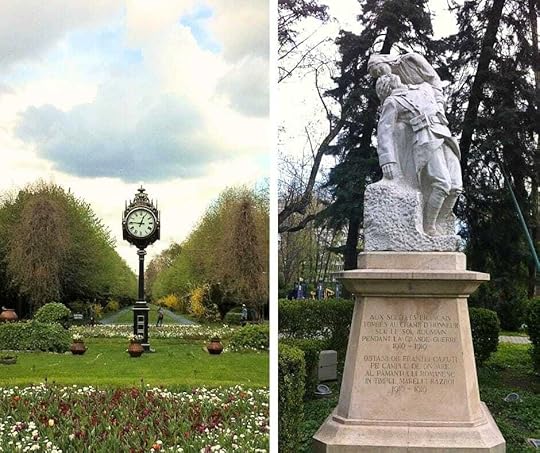
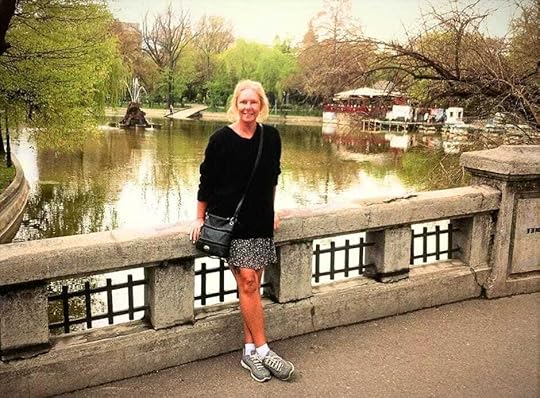 Photo opportunity – taking a walk around Cismigiu Park
BUCHAREST ART SCENE
Photo opportunity – taking a walk around Cismigiu Park
BUCHAREST ART SCENE
Bucharest is known for its music scene and its energetic nightlife, from trendy bars in the Old Town to emphasis on classical music in the parks during hot summer evenings.
There really is something for everyone and this includes a diverse art scene with lots of art galleries and art markets and a thriving street art scene. Arthur Verona Street and Graffiti Urban are known locations for colourful murals and street art installations.
Why not take a street art tour of the city’s alternative art spaces that buzz with a contemporary energy. Or simply wander through the city streets and passageways and the green parks. I enjoyed coming across many of the city’s statues and sculptures while getting lost in Bucharest’s immersive cultural embrace.
The photos below are taken outside The Grand Hotel (then The Intercontinental) which is located next to the National Theatre in Bucharest where you can see these fabulous sculptures of famous Romanian playwright Ion Luca Caragiale (I. L. Caragiale).
 The Caragealiana statue outside the National Theatre in Bucharest
The Caragealiana statue outside the National Theatre in Bucharest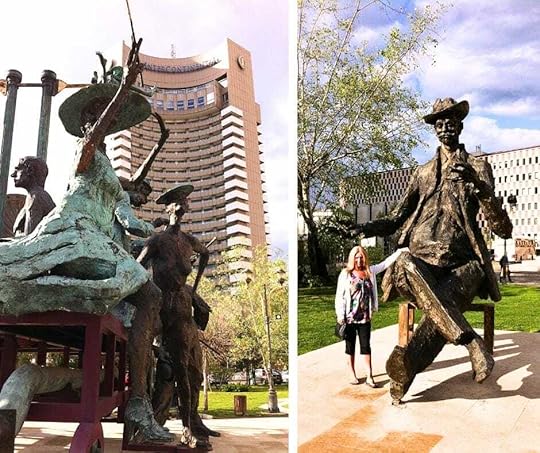 Sculptures of famous Romanian playwright Ion Luca Caragiale (I. L. Caragiale) 1852 -1912
BUCHAREST CAFE CULTURE
Sculptures of famous Romanian playwright Ion Luca Caragiale (I. L. Caragiale) 1852 -1912
BUCHAREST CAFE CULTURE
Thirsty and hungry yet? Take a street food tour or looking for an interesting cafe? Bucharest is a café lover’s dream. The Old Town (Centrul Vechi) is packed with lively cafés, quirky bars, and eclectic restaurants, perfect for an afternoon espresso or a late-night cocktail.
For something truly special, visit Caru’ cu Bere, a gothic-style beer hall that feels like stepping into another century. Romanian cuisine is hearty, flavourful, and surprisingly diverse. Think sarmale (cabbage rolls), ciorbă de burtă (tripe soup), and mititei (grilled meat rolls) paired with local wines or țuică, a powerful plum brandy.
 The Heart of Bucharest – History, Architecture & Old Town Vibes
MY THREE DAY ITINERARY FOR BUCHAREST
Day 1: The Heart of Bucharest – History, Architecture & Old Town Vibes
The Heart of Bucharest – History, Architecture & Old Town Vibes
MY THREE DAY ITINERARY FOR BUCHAREST
Day 1: The Heart of Bucharest – History, Architecture & Old Town Vibes
Morning: Palace of the Parliament – Start your day with a tour of this jaw-dropping symbol of Ceaușescu’s reign. It’s massive, ornate, and full of stories. Book a tour in advance. Then walk down Bulevardul Unirii, designed to rival the Champs-Élysées, and take in the imposing socialist architecture.
Lunch: Hanu’ lui Manuc – A historic inn turned traditional restaurant. Enjoy Romanian classics like sarmale or ciorbă de burtă in a charming courtyard.
Afternoon: Old Town (Centrul Vechi) – Explore cobbled streets full of lively cafés, boutiques, and bookstores. Visit Stavropoleos Monastery – A tiny, serene 18th-century church with beautiful frescoes and stone carvings. Stop by Carturești Carusel, a dreamy multi-level bookstore often called one of the most beautiful in the world.
Evening: Have Dinner at Caru’ cu Bere – An iconic neo-Gothic beer hall with stained glass, traditional food, and folkloric ambiance. Grab a drink in Lipscani District – explore rooftop bars like Nomad Skybar or a cocktail bar like Fix Me a Drink.
Day 2: Parks, Museums, and Romanian CultureMorning: Herastrau Park (King Michael I Park) – Rent a bike or boat and cruise the lake. Then stop at Dimitrie Gusti Village Museum, located inside the park. It’s an open-air museum with traditional houses and buildings from across Romania.
Lunch: Eat at Hard Rock Café by the lake or try Casa Doina for a more refined Romanian meal in a historic building.
Afternoon: Visit the Romanian Athenaeum – A neoclassical concert hall and national symbol. Even if you don’t see a concert, the interior is stunning. Then explore The National Museum of Art of Romania (inside the former Royal Palace) for European and Romanian masterpieces.
Evening: Dinner in the trendy neighbourhoods of Dorobanți or Floreasca with upscale restaurants and cafés. Try Kane or Sardin for modern Romanian or Mediterranean fusion. Optional: Catch a show at the Bucharest National Opera or Teatrul Național.
Day 3: Local Life, Hidden Gems & Day TripsMorning: Explore Calea Victoriei, one of the oldest and most elegant streets in Bucharest. Stop by George Enescu Museum (a beautiful art nouveau villa), and check out the Macca-Vilacrosse Passage, a hidden arcade with stained-glass ceilings.
Optional Shopping: Browse for antiques and local crafts at Obor Market (for a raw local vibe) or Baneasa Shopping City for modern retail.
Optional Half-Day Trip: Mogoșoaia Palace – A beautiful and nearby 17th-century palace and gardens.
Late Afternoon / Evening: Wind down with a quiet walk in Gradina Cismigiu, Bucharest’s oldest public garden. Final dinner at The Artist – One of the city’s top fine-dining experiences with creative Romanian-inspired dishes.
SEE MY BUCHAREST THREE DAY ITINERARY ON GOOGLE MAPS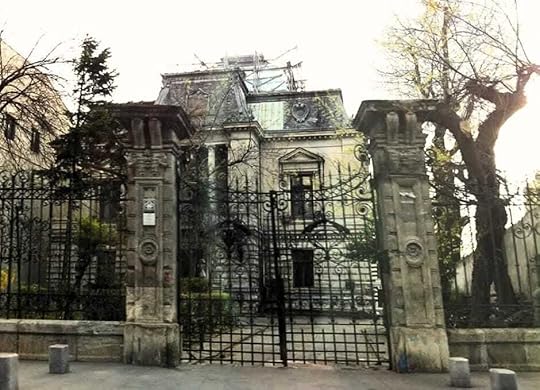 I took this photo of an old French style house in Bucharest as it looked so spooky!
MY TOP TIPS FOR BUCHAREST
I took this photo of an old French style house in Bucharest as it looked so spooky!
MY TOP TIPS FOR BUCHAREST
Wear comfortable shoes as the Old Town and historical areas are best explored on foot.
Book trips and tours and tickets online and in advance to avoid disappointment.
Bookmark My Bucharest Three Day Itinerary on Google Maps.
Keep your personal belongings secure especially in crowded areas like the Old Town.
Learn a few Romanian phrases as it’s appreciated even though English is widely spoken.
LEARN A FEW PHRASES IN ROMANIAN1. English: Hello / Good day
Romanian: Bună / Bună ziua Pronunciation: boo-nuh / boo-nuh zee-wah
2. English: Do you speak English?
Romanian: Vorbiți engleză? Pronunciation: vor-beets en-gleh-zuh?
3. English: How much does this cost?
Romanian: Cât costă asta? Pronunciation: kut kos-tuh ah-stah?
4. English: Thank you / You’re welcome
Romanian: Mulțumesc / Cu plăcere Pronunciation: mool-tsoo-mesk / koo pluh-cheh-reh
5. English: I would like a coffee, please
Romanian: Aș dori o cafea, vă rog Pronunciation: ash doh-ree oh kah-fee-ah, vuh rog
 Bucharest City Centre
WHEN IS THE BEST TIME TO VISIT BUCHAREST ROMANIA?
Bucharest City Centre
WHEN IS THE BEST TIME TO VISIT BUCHAREST ROMANIA?
A month-by-month guide to visiting Bucharest, Romania, including weather, tourist flow, and key festivals or events that might help you choose the best time to visit. Correct at time of writing. Do check ahead for seasonal events and opening times.
Generally, the best time to visit Bucharest is during the spring (April to June) and early autumn (September to early October). May and September hit the sweet spot for weather, events and manageable crowds.
March (Spring Awakening) Weather: 10–22°C (50–71°F). Blossoming parks, fewer tourists, cozy café culture. Events: March 1: Mărțișor – Traditional spring celebration with red-and-white tokens.
April to June (Spring) Mild temperatures (15–25°C / 59–77°F) perfect for walking tours and outdoor cafés. Parks in bloom: Herăstrău and Cismigiu Gardens are vibrant and colourful. Fewer tourists: Less crowded than summer. Events: May Street Festival: Art, music, and urban projects on Arthur Verona Street
June – August (Summer Buzz) Weather: 25–35°C (77–95°F) Lively nightlife, outdoor terraces, open-air events. Hot weather and more tourists. Events: June: B-FIT in the Street! International street theatre festival. July: Summer Well Festival. Indie music festival just outside the city. August: George Enescu Festival (biennial). Prestigious classical music event.
July–August (Summer) Can be hot (up to 35°C / 95°F) and some locals leave for vacation making parts of the city feel quieter. Lots of events and festivals. Great nightlife.
September to early October (Autumn) Cool comfortable climate: Great for city exploration without the summer heat. Fall colours: Bucharest’s many tree-lined streets and parks are beautiful in gold and red. Cultural season: Theatres, opera, and concerts resume after summer breaks.
September – October (Golden Autumn) Weather: 15–25°C (59–77°F). Perfect walking weather, vibrant fall colours
Events: September: Bucharest International Film Festival (BIFF). October: White Night of the Galleries. Contemporary art in open galleries citywide
November – February (Winter & Holidays) Weather: -5 to 5°C (23–41°F) Festive vibe, snow-dusted architecture. Cold, shorter daylight hours.
Winter (December–February) Festive Christmas markets especially around University Square. Cold weather and shorter days so some sights may have limited hours. Events: December: Christmas Market at University Square – Lights, mulled wine, crafts. January 24: Unification Day – Cultural events and parades. February: Dragobete (Feb 24) – Romanian Valentine’s Day.
Do you enjoy European City Breaks?
Have you visited Romania yet?
Let me know – leave a comment.
Tell me if this post has been helpful?
THE BACKPACKING HOUSEWIFE RECOMMENDS TRAVEL INSURANCE

The post Romania: Bucharest appeared first on The Backpacking Housewife.
May 1, 2025
Over 50’s Guide To Adventure Travel
Adventure travel today is about living fully, being active, and prioritizing joy, growth, and health. In my own experience, life after 50 can be one of the best times to embrace exciting new experiences, and to rediscover the thrill of trying something bold and adventurous.
Be assured, stepping out of your comfort zone doesn’t mean putting yourself in danger, because to me adventure travel is less about risk and more about rediscovery.
So, whether you’re newly retired, planning a sabbatical, or still balancing work and personal time, here is my Over 50’s Guide to Adventure Travel and my suggestions for 10 Adventurous Activities that can offer you physical and emotional benefits, as well as perhaps igniting a new passion!

TABLE OF CONTENTS
OVER 50’S GUIDE TO ADVENTURE TRAVEL10 ADVENTURE TRAVEL ACTIVITIES1. HIKING AND TREKKING ADVENTURES2. SCUBA DIVING OR SNORKELLING ADVENTURES3. BIKING ADVENTURES4. CULTURAL ADVENTURES5. VOLUNTEERING ADVENTURES6. ROAD TRIP ADVENTURES7. WELLNESS RETREAT ADVENTURES8. WILDLIFE ADVENTURES9. FOOD AND DRINK ADVENTURES10. CLASSES AND WORKSHOP ADVENTURESWHY ADVENTURE AFTER 50?BEFORE YOU GO ON AN ADVENTURE 10 ADVENTURE TRAVEL ACTIVITIES 1. HIKING AND TREKKING ADVENTURESHiking and trekking are becoming more and more popular as it is a low-impact way to experience adventure travel in breath taking landscapes while challenging your body at your own pace.
Whether you’re walking a local trail from home, taking a day trip into nature, or heading for the mountains, hiking and trekking is scalable to your own fitness level.
I personally enjoy taking adventurous day hikes when I’m exploring a country. In Penang Malaysia, for example, I trekked up Penang Hill and enjoyed the flora and fauna of the ancient rainforest. Although, on that particular day, it was so misty at the top (700 metres above sea level) that I didn’t get to see or appreciate the fine views.
In Japan, on Miyajima Island, I spent a day hiking (535 metres above sea level) up Mount Misen (and also took advantage of the ropeway) to reach the sacred site of The Shrine of the Eternal Flame.
This year, I was thinking of doing the Camino de Santiago Pilgrimage ‘The Way of St. James’. There are many different hiking routes over differing distances from France, Portugal and Spain, all leading to Santiago de Compostela in Galicia, in Northern Spain. But that particular trek is now so popular and overcrowded that I’m rather put off participating.
Instead, next time I’m in Japan, I’m seriously considering hiking part of The Shikoku 88 Temples Pilgrimage. It is a spiritual circular route on the Japanese island of Shikoku, visiting 88 Buddhist temples over a total distance of 750 miles.
If hiking and trekking appeals to you then I suggest starting with short local day-hikes and gradually work up to longer or more challenging and longer-distance treks. Invest in (affiliate links) a lightweight backpack and quality footwear and trekking poles for comfort and balance.
But, if you’re a traveller seeking more adventurous thrills, then perhaps Everest Base Camp, Annapurna and Manaslu Circuit Trek are on your travel bucket list and Nepal is calling you? Or, maybe you just want to step into the mountains and discover a new side of yourself, as you breathe in the fresh mountain air of the Himalayas?
If so, then you’ll want to consider taking an expert guided tour (sponsored link) with Royal Holidays Adventure – an experienced company who cater for many travel styles in exotic settings. They can provide trekking, hiking, off the beaten track, and scenic tours, in Nepal, Bhutan, and Tibet, while also practicing responsible and sustainable tourism.
Why Try It: Guided trekking can offer fabulous opportunities to explore nature and wilderness and remote terrain – or even more challenging and adventurous environments – with companionship and in safety and with expert guidance.
The benefit of walking is proven to reduce stress and increase mental clarity and cardiovascular health as well as bone density, leg strength, and joint mobility.
 Everest Base Camp: Photo credit Royal Holidays Adventure2. SCUBA DIVING OR SNORKELLING ADVENTURES
Everest Base Camp: Photo credit Royal Holidays Adventure2. SCUBA DIVING OR SNORKELLING ADVENTURESScuba diving offers an adventure in an entirely different world and learning to scuba dive is on many people’s wish lists, especially in the tropics when the water is clear and warm, and the underwater world is vibrant and colourful.
Many destinations have dive shops offering Discover Scuba Diving experiences and beginner certifications like Open Water Diver and Advanced Diver and warm water destinations like the Caribbean or Thailand offer calm clear waters that are ideal for snorkelling or diving.
If you’ve read some of my other posts, you’ll know that during our first years of travelling the world, my backpacking husband’s great passion was scuba diving.
While we travelled, he gained more and more scuba diving qualifications. In the Caribbean he trained for three months as a Dive Master, after which he went on to achieve Assistant Instructor then while in Thailand he became and Instructor. After ten years of training, he reached IDC Staff Instructor and then Course Director.
I am not a scuba diver myself, but I do love to swim in the ocean and to snorkel over a reef, which I recommend to anyone as a gentler and more accessible option, if deeper water and scuba is not your thing.
In my experience, snorkelling in the warm clear shallows over a coral garden, you can often see shoals of colourful fish going about their fishy business and observe turtles, crabs, and other crustaceans and aquatic life, just as you could if you were diving.
Why Try It: Being on the ocean is an adventure and exploring the mesmerising underwater world can boost mental wellbeing. Physically, scuba diving and snorkelling enhances breathing efficiency and lung function and offers a sense of weightlessness that’s easy on joints.
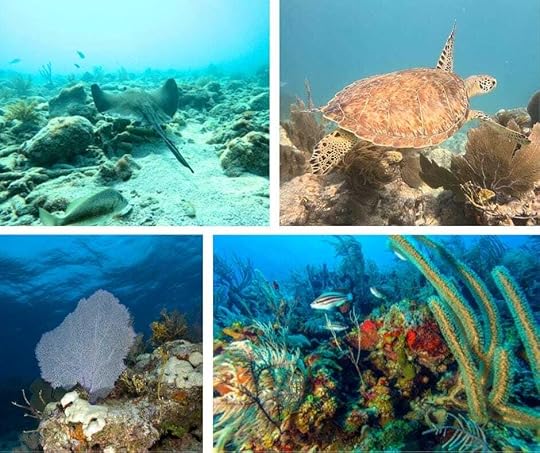 Scuba diving offers an adventure in an entirely different world3. BIKING ADVENTURES
Scuba diving offers an adventure in an entirely different world3. BIKING ADVENTURESBiking is an adventurous activity that’s also scalable to one’s own fitness and energy levels and needn’t be as exhausting as walking because you can always choose to ride a bicycle with battery power!
Whether you’re cycling through Europe or exploring bike trails closer to home, biking is a heart-healthy, joint-friendly adventure that strengthens muscles, especially the legs and core, is great cardiovascular endurance and promotes balance and coordination.
Cycling is a wonderful way to really experience a country and I’ve taken to pedal power in many countries of the world and have photos to prove it!
I personally have enjoy cycling and, while in France recently, I rode my bike with friends along a riverbank pathway and through a park, stopping off for a light lunch along the way. It was a wonderful way to spend a sunny Sunday.
I’ve rented a bike to explore the small island of La Digue in Seychelles – where there are no cars allowed – pedalling through palm tree plantations, discovering incredibly beautiful beaches like the beach at Anse Source D’Argent – while befriending giant tortoises.
I’ve also cycled over the Golden Gate Bridge while spending a few days in San Francisco. And, in Central Vietnam, I’ve cycled from Hoi An to the beaches at Cua Dai and An Bang along the elevated pathways between the rice fields.
Why Try It: You can set off on your cycling adventure alone or you can consider a cycling tour. These can range from scenic day trips to multi-day excursions with sociable stop offs, comfortable accommodations, and support vehicles (with extra batteries if your electric bike should require a pitstop!).
 Cycling is a wonderful way to really experience a country4. CULTURAL ADVENTURES
Cycling is a wonderful way to really experience a country4. CULTURAL ADVENTURESOne of my very favourite things to do is to explore cultural sites all over the world. Delving into a place of rich history, old traditions, and learning about the customs of different cultures is like seeing through a window into the past or reaching into another world.
I love museums and visiting places of cultural interest and I particularly enjoy the sites of ancient temples and old castles because their splendour is in the atmospheric, often spiritual, ruined but tangible history, you can touch and see for yourself.
I’ve often felt overwhelmed and emotional in places of cultural immersion – like in the Golden Temples of Chiang Mai in Thailand, in Egypt at the Museum of Antiquities and the Pyramids at Giza – and again at the vast Angkor Wat Archaeological Park in Cambodia.
Why Try It: Immersing yourself in the past by exploring ancient ruins, archaeological sites, and experiencing cultural heritage stimulates the mind and enhances global awareness and empathy. Cultural sites also promote walking and light physical activity.
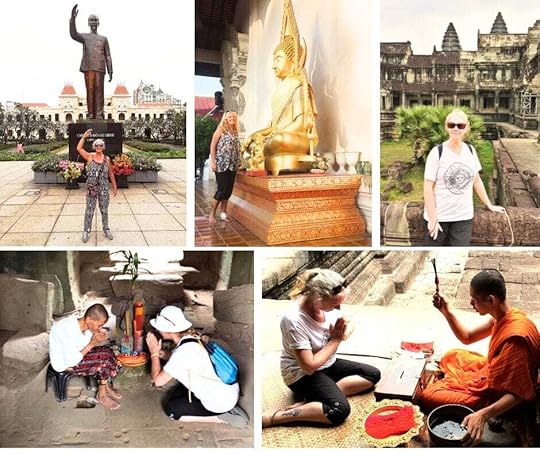 One of my very favourite things to do is to explore cultural sites all over the world5. VOLUNTEERING ADVENTURES
One of my very favourite things to do is to explore cultural sites all over the world5. VOLUNTEERING ADVENTURESWhy not combine travel with purpose by volunteering overseas? From teaching English as a second language, to helping communities build homes and infrastructure, to helping in wildlife conservation, volunteering brings the opportunity to make a positive impact and gain a deeper understanding of global issues. It’s adventure with heart.
There are lots of organizations that offer programs tailored to offer volunteering opportunities. I recommend you choose one that aligns with your passions and physical abilities and then do your research to make sure the work they do is not for profit but for the good of the cause they are supporting.
I once arranged to spend a day helping at The Sepilok Orangutan Sanctuary in Borneo when I was researching for my book ‘The Backpacking Housewife’. And, I once spent a wonderful week volunteering at a Turtle Sanctuary while my backpacking husband was on a diving adventure.
I went to Perhentian Islands off the coast of Malaysia to help at ‘Bubbles’ Turtle Sanctuary. They take volunteers every year during the nesting season. It was a wonderful life-affirming and emotional experience for me that I will never forget.
Patrolling the beach at night under a full moon when a huge green turtle was heaving herself up the beach to lay her eggs, and in the daytime, seeing hundreds of baby hatchling turtles coming out of a nest and making their way to the ocean.
Why Try It: Volunteering your time and your expertise gives back to communities in need while you are experiencing a new culture and a sense of purpose and also adventure that can be incredibly rewarding.
Ideas for volunteering projects can include: wildlife conservation and monitoring – coral reef preservation and restoration – beach cleanups – reforestation and sustainable farming – building and infrastructure – clean water projects – teaching languages or sports – medical and wellbeing assistance. Etc!
 Why not combine travel with purpose by volunteering overseas?6. ROAD TRIP ADVENTURES
Why not combine travel with purpose by volunteering overseas?6. ROAD TRIP ADVENTURESI’m a lover of the open road and of road trips. So, of course, you’ll find many posts on road trips adventures on this website because being ‘on the road’ is not just about the destination but about the journey itself.
Road tripping gives a sense of freedom and independence and is often a flexible and affordable way to travel. If you have your own vehicle then a road trip can be done at your own pace. You can follow quirky road signs just to see what’s there and you can stop off where and whenever you want.
If you are travelling as part of a tour or on public transport, then there’s a great benefit to leaving the driving to someone else. For example, you get to relax and look out of the windows and see everything passing around you in a way you couldn’t if you were driving.
I’ve travelled through France several times by coach and by bus and I highly recommend traveling from Miami to Key West by Greyhound Bus. It’s a fabulous way to travel over all those bridges on Highway One and, of course, you can get off and stay overnight (we did on Key Largo) before travelling onto Key West (over Seven Mile Bridge) by Greyhound Bus the following day.
I’ve also travelled by tour bus from Las Vegas to The Grand Canyon South.
A fantastic trip of 275 miles (440 km) stopping off at Lake Mead, Hoover Dam, and at all those quirky little old towns like Flagstaff, the old Santa-Fe railroad town of Seligman, and the old road to Kingman, all on the historic Mother Road of Route 66!
Why Try It? Road trips turn the journey into the main event. Experience changing landscapes, quirky towns, and hidden gems you’d never find otherwise. There’s something mentally refreshing about being on the road. Long drives can give you time to think, reflect, clear your mind or just zone out with good music. Road trips can be full of surprises – unexpected detours might happen – but they can also make you feel alive and in the moment.
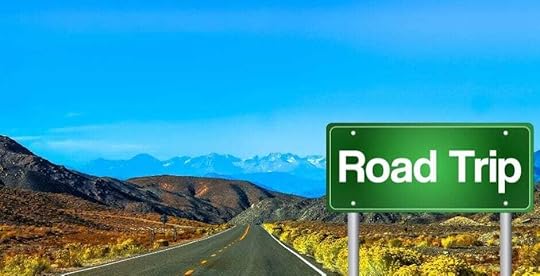 Road trips turn the journey into the main event!7. WELLNESS RETREAT ADVENTURES
Road trips turn the journey into the main event!7. WELLNESS RETREAT ADVENTURESWhy not see the world while working on yourself? Turn a holiday vacation into a meaningful, soul-nourishing experience, by exploring new cultures through healing traditions.
Wellness retreat adventures are the perfect way to combine travel with recharging your body, mind, and soul. Step away from screens, notifications, and burnout. Reconnect with stillness, nature, and your inner rhythm.
I’m feeling interested in wellness retreats right now, as I try to process the grief of losing my darling backpacking husband, in a safe and supported place where I can reflect on how I might come to terms with a solo life after forty-five years of being one half of a happily married couple.
Right now, I’m considering yoga and meditation retreats in India or immersive sound healing and Chakra balancing in Bali. Or even ocean meditation on a remote tropical island beach. Shinrin-yoku (forest bathing) amongst the ancient cedar groves of Japan. Or, maybe, nature-therapy at a jungle retreat with eco-living vibes in Costa Rica.
I’d like to feel grounded again and learn the tools for sustainable wellness with practiced breathwork, mindfulness, and clean eating. I’d like to detox physically and mentally, with a focus on diet, fitness, and sleep, so I can live a healthier lifestyle while I try and process my trauma and my life’s changes.
Maybe the geothermal spas, glacier treks, and wellness under the northern lights, are calling me from Iceland?
You might just like to escape stress, noise, and the pressure of daily life. Trade city noise for ocean waves, mountain air, or jungle sounds. To rewild your senses and to remember how it feels to just be.
Why Try It? A wellness retreat adventure isn’t just a trip — it’s an intentional pause. Give yourself permission to rest, reflect, and heal. Show yourself love by prioritizing your wellbeing. Leave feeling stronger, lighter, and more in tune.
 Give yourself permission to rest, reflect, and heal8. WILDLIFE ADVENTURES
Give yourself permission to rest, reflect, and heal8. WILDLIFE ADVENTURESFor many animal lovers, especially those with photography skills, the experience of an African Safari would be the adventure of a lifetime.
Seeing elephants, hippos, and big cats in the Kruger National Park, South Africa, with Big Five game drives and luxury bush lodges.
But there are so many other options, too, for wildlife adventures.
From river-based wildlife spotting in the Amazon (Peru, Ecuador, Brazil) or a jungle trek to see primates in Uganda or, as I have experienced myself, orangutans in the wild in Borneo.
Another amazing and exciting wildlife adventure that I’ve experienced was swimming with a whale shark, and with a pilot whale and her baby, and with a pod of dolphins – all on one mind-blowingly amazing day on the Caribbean Sea.
What’s on your wildlife travel adventure wish list?
The National parks – the Grand Canyon – Yellowstone – in the USA?
For me, it would have to include Galápagos Islands, Ecuador, seeing the Great Barrier Reef, Australia and taking part in an Antarctica Expedition Cruise to see penguins, seals, whales, and icebergs. And, I’d love to go to the Komodo Island, Indonesia to track Komodo dragons in their natural habitat.
Why Try It? Whether seeking adventure, meaning, or inspiration, a wildlife experience taps into our human desire to explore and to protect the natural world. Wildlife adventures can provide and a chance to reconnect with nature, experience rare and thrilling encounters, and support conservation efforts.
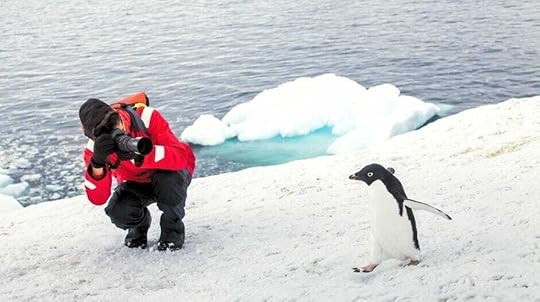 What’s on your wildlife travel adventure wish list?9. FOOD AND DRINK ADVENTURES
What’s on your wildlife travel adventure wish list?9. FOOD AND DRINK ADVENTURESI love food and drink adventures. For me, it’s one of the best reasons to travel!
Whether you’re a hardcore foodie, a street food scavenger, or someone who just loves a good glass of wine with a view, there’s a whole world of delicious experiences out there.
If you, like me, you are a travel foodie, do check out some of my travel posts featuring food and drink experiences. For example, while housesitting and living in France – and trying all 365 varieties of French cheese – I wrote about (and mapped out) my favourite vineyard tour of wine chateaux in Bergerac.
In Penang – known as the Food Capital of Malaysia – I wrote (enthusiastically) about my Food Tour with Friends. And, in Taiwan, I sourced and sampled the famous Michelin Star Street Food at Ningxia Night Market in Taipei.
Enjoying world foods is a true pleasure for me as well as a great adventure.
You might enjoy pad-thai in Bangkok, mango sticky rice in Chiang Mai, grilled skewers. In Pattaya, delicious boat noodles in Koh Samui. In Singapore, hawker stalls and gourmet pop-ups. In New Orleans, USA, Cajun-Creole flavours during Jazz Fest or Mardi Gras.
Those of you with a sweet tooth would LOVE the amazing cakes at China House in Penang. In Austria, there’s Sachertorte and apple strudel. In Japan, try the unique and quirky varieties of KitKats, mochi, and traditional wagashi sweets.
For those of you who enjoy wine – adventure travel wine tours might also take you to destinations such as Germany, Italy, Spain, Portugal, The United States, Australia, Argentina, Chile, South Africa and New Zealand.
Beer lovers can enjoy brewery and craft beer adventures in Belgium for monastic breweries, trappist ales, and beer + chocolate pairings. In Germany for beer gardens, Oktoberfest, and brewery tours in Munich or Cologne. In Portland, Oregon beer lovers can enjoy IPAs, sour ales, and barrel-aged stouts.
And what about those of you who enjoy spirits and whisky? Well, I can absolutely recommend distillery experiences in the Highlands and in Speyside, Scotland.
Then, in the USA there’s the Bourbon Trail through the heart of Kentucky. And in Mexico you might like to try tequila or mezcal tours with agave field visits. In Japan there’s sake tasting and brewery visits in Kyoto or Niigata.
Why Try It? A food or drink tour offers the traveller a rich and rewarding adventure, blending culture, history, and sensory discovery into one unforgettable experience. Whether savouring world-famous wines, sampling bold whiskies, or exploring vibrant food markets, a culinary journey is a delicious and joyful way to truly experience the heart of a destination!
 A culinary journey is a delicious way to experience the heart of a destination!10. CLASSES AND WORKSHOP ADVENTURES
A culinary journey is a delicious way to experience the heart of a destination!10. CLASSES AND WORKSHOP ADVENTURESThere are so many different opportunities available to travel and to learn. Whether you want to learn something new, like a language, or hone your talents and skills with a workshop, travel adventures that combine classes and workshops can be fabulous and purposeful.
A writing workshop is an amazing way to tap into your creative side or to pen your memoir while you travel. I once enjoyed a writer’s retreat in a house on the top of a cliff overlooking the sea in Scotland.
It was wonderful to be in such an inspiring environment and able to focus on my writing in my own room or in the beautiful conservatory with a view. And, during coffee breaks and mealtimes and over evening cocktails, it was fantastic to chat with other writers about writing.
What would be your focus for a class or workshop travel adventure?
Might it be a cooking classes? I once took a cooking class to learn how to make Taiwanese dumplings.
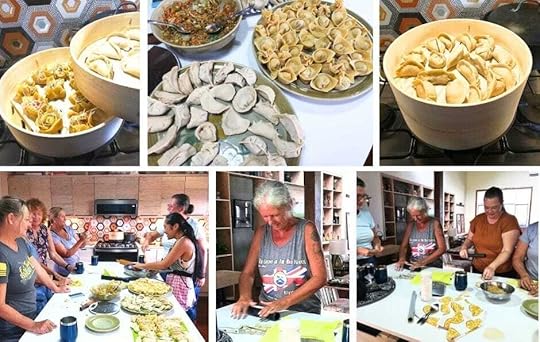 Taiwanese Dumpling Cooking Class!
Taiwanese Dumpling Cooking Class!In Japan you can learn sushi rolling, ramen broths, or wagashi (sweet) making. Or perhaps Morocco for tagine cooking with market-fresh spices. Or in India, learning to make curries, samosas, and chai in a home kitchen?
Perhaps a photography class, where you’d learn how to shoot landscapes, action shots, wildlife, or local life with impact. Ideally, in Iceland (landscapes), Kenya (safari photography), Nepal (mountains), or Japan (urban + culture)
Maybe you prefer to learn something earthy and hands-on like wood carving, leatherworking, pottery, or natural dyeing. This might take you to one of the Nordic countries (knife-making), Japan (ceramics), Peru (weaving), or Guatemala (textiles).
Taking an art workshop while travelling could help you see the world differently and express what a photo can’t always capture. Sketching or painting landscapes, wildlife, and people on location could help you use colour and composition to express feeling and not just realism. Try Aboriginal dot painting (Australia) or Mola stitching (Panama) or perhaps Indigo dyeing or woodblock printing (Japan) or fresco painting or mosaic art (Italy or Greece).
Why Try It? Depending on where you are, you might also learn to train your eye to see beauty in a new light that enables you to capture the finer details of shadows, textures, and patterns.
 What would be your focus for a class or workshop travel adventure?
What would be your focus for a class or workshop travel adventure?OVER 50’S GUIDE TO ADVENTURE TRAVEL
WHY ADVENTURE AFTER 50?I believe that there are many reasons why adventure travel is particularly beneficial for the 50 plus age group. New experiences stimulate the brain, keeping it sharp and engaged. Overcoming challenges, exploring new cultures, and pushing your boundaries can boost your confidence and combat feelings of stagnation, especially as we get older.
Plus, adventure travel provides opportunities for exercise that are far more engaging than a treadmill. Think hiking, cycling, swimming, and even gentle climbing – it’s all disguised as fun!
And, I always feel that stepping away from the everyday routine and immersing yourself in nature or a new environment, can significantly reduce stress levels.
As a newbie solo traveller, I know I’ll enjoy planning and travelling independently, but there are some situations and there are some destinations where I would certainly find organising transport difficult or feeling safe as a woman travelling alone. In these circumstances, I’d feel much more confident travelling as part of an organised tour group. Group travel adventures also offer fantastic opportunities to meet like-minded individuals and forge new friendships.
 I believe adventure travel is particularly beneficial for the 50 plus age group
BEFORE YOU GO ON AN ADVENTURE
I believe adventure travel is particularly beneficial for the 50 plus age group
BEFORE YOU GO ON AN ADVENTURE
Before embarking on any adventure, it’s essential to consider your health, fitness level, and any pre-existing medical conditions. Consult with your doctor to ensure that you’re fit for the activities you have planned. Pack appropriately for the climate and terrain and always prioritize safety. Travel insurance is a must – read my post on Travel Insurance for Over 50’s – and be sure to inform your insurer of any planned adventurous activities.
THE BACKPACKING HOUSEWIFE RECOMMENDS TRAVEL INSURANCE
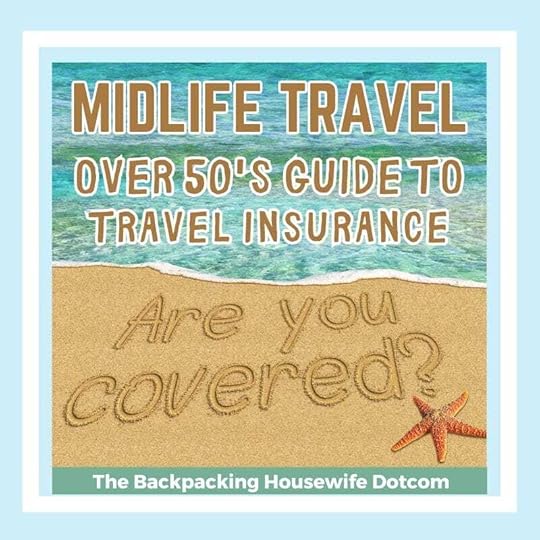
The post Over 50’s Guide To Adventure Travel appeared first on The Backpacking Housewife.
April 10, 2025
Discovering Key Largo
Key Largo is the first and the northernmost territory in the string of idyllic islands off continental USA known as the Florida Keys. As such, Key Largo serves as the gateway to a tropical paradise and a tranquil escape, just an hour’s drive and what seems like a whole world away from Miami.
Key Largo was named after the Spanish word “Cayo Largo” meaning “long key” as it spans over 30 miles (48 km). The island is renowned for its breath-taking views, diverse marine life, and with crystal-clear waters, vibrant coral reefs, as the self-proclaimed “Diving Capital of the World.”
The backpacking husband and I travelled from Miami to Key West on US Highway One by Greyhound Bus, stopping off at Key Largo for a couple of nights, to see what Key Largo had to offer us.
I was particularly looking forward to discovering Key Largo and relaxing at our resort hotel, exploring the local cuisine and all the visitor attractions – I was very excited about seeing the original African Queen – the original boat from the classic 1951!
For the backpacking husband, a stop off in Key Largo meant scuba diving and a much-anticipated shopping trip to the vast Diver’s Direct warehouse in Key Largo!
But whether you’re seeking relaxation and rejuvenation or drawn to natural beauty, underwater adventures, or serene beaches, Key Largo has something for everyone.
Let’s dive into the best of Key Largo and discover why it’s a must-visit destination.
 Discovering Key Largo
Discovering Key LargoTABLE OF CONTENTS
DISCOVERING KEY LARGOWHERE TO STAY IN KEY LARGO10 REASONS TO VISIT KEY LARGOBEST TIME TO VISIT KEY LARGODISCOVER THE MAGIC OF KEY LARGO WHERE TO STAY IN KEY LARGO
WHERE TO STAY IN KEY LARGO
Key Largo offers a wide variety of hotels, motels, resorts, guest houses, inns, BB’s and vacation rentals. We stayed at The Holiday Inn Key Largo. It’s located on Key Largo Marina which hosts fishing, dive boats, and the Key Largo Princess glass bottom boat. Also it’s conveniently located for the prementioned boat trip on the African Queen!
I really enjoyed our room at Holiday Inn Key Largo with a balcony overlooking the marina. There’s also two really nice swimming pools and lots of outdoor places to relax.
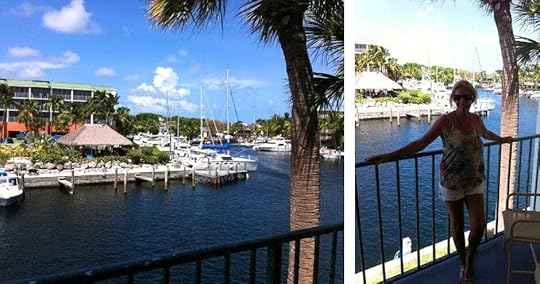 We stayed at The Holiday Inn Key Largo.
We stayed at The Holiday Inn Key Largo. FIND YOUR PERFECT PLACE TO STAY USING THIS INTERACTIVE MAP
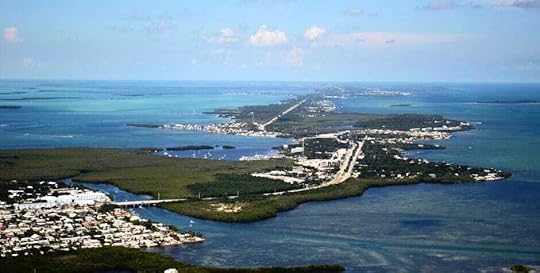 Key Largo is just an hour’s drive and what seems like a whole world away from Miami
10 REASONS TO VISIT KEY LARGO
Key Largo is just an hour’s drive and what seems like a whole world away from Miami
10 REASONS TO VISIT KEY LARGO
1. Scuba Diving: Key Largo claims to be one of the best places in the world to go scuba diving. So a visit to Key Largo would be incomplete without exploring the renowned John Pennekamp Coral Reef State Park – the first underseas park in the USA – together with the neighbouring Florida Keys National Marine Sanctuary that together cover around 178 nautical square miles of coral reefs, seagrass beds and mangrove swamps.
If you’re new to scuba diving then you can take a Discover Scuba Course or get your PADI Open Water Qualification at one of the many dive centres. Advanced divers and those who already have dive qualifications can enjoy guided tours of the reef and get to see the iconic Christ of the Abyss statue that is submerged 25 feet underwater.
Find out more Key Largo Scuba Diving.
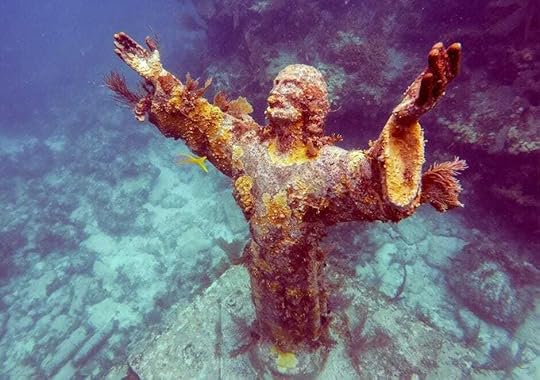 The iconic Christ of the Abyss statue is submerged 25 feet underwater
The iconic Christ of the Abyss statue is submerged 25 feet underwater2. Reef Snorkelling: Another way to experience the park’s vibrant coral reefs and marine life is to take a snorkelling tour. Delight in the vibrant coral, reef fish, and diverse marine life. Whether you’re a beginner or an expert, a half-day adventure is a must. You will be supplied with snorkelling equipment and reef-safe sunscreen. Just bring your towel and snacks for an unforgettable underwater experience.
Find out more Key Largo Snorkelling.
 Delight in the vibrant coral, reef fish, and diverse marine life
Delight in the vibrant coral, reef fish, and diverse marine life3. Visit the African Queen Canal Cruise: Step aboard the historic African Queen, the original vessel from the classic 1951 film starring Humphrey Bogart and Katherine Hepburn. The vessel was built in 1912 in Lytham England and was originally named The S/V Livingston. She was shipped to the British East Africa Railway Company to work on the Victoria Nile and Lake Albert carrying cargo, missionaries and hunting parties.
In 1951 John Huston saw the vessel and commissioned her for the movie he was directing – The African Queen. In 1968 the boat was brought to the USA for charter operations by a San Francisco restaurant owner. In 1970 Hal Bailey bought the vessel for the price of her boatyard bill and chartered her in Oregon before bringing her to Florida for a year round charter operation.
In 1982 Jim Henricks Snr. purchased and brought the vessel to Key Largo where he restored her to be historically correct. Her boiler is custom made and historically correct and her steam engine is from 1896. The vessel is now on the American Historic Register. He showed her all over the world, taking her to London, Sydney and New York amongst many other places. He enjoyed a constant correspondence with Katherine Hepburn who was happy that ‘The Old Queen’ had been saved again.
She has to be meticulously maintained in order to preserve her. She was restored in 2012 by Suzanne and Lance Holmquist in conjunction with Jim Hendricks Jnr. For her centennial year celebration she received a new boiler while her steel hull and engine were rebuilt.
The canal cruise provides a unique opportunity to explore Key Largo’s waterways while learning about the boat’s fascinating history. It’s a memorable experience that combines Hollywood glamor with the island’s natural charm.
Find out more African Queen Boat Tour.
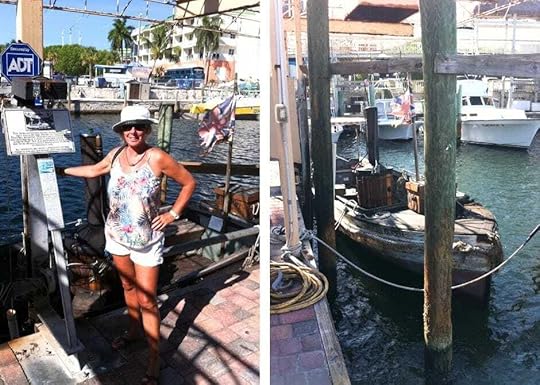
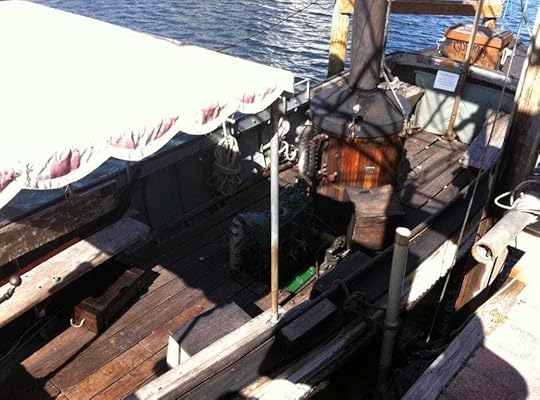 Step aboard the historic African Queen – the original vessel from the classic 1951 film
Step aboard the historic African Queen – the original vessel from the classic 1951 film4. Enjoy A Floating Tiki-Bar Experience! This is a one-of-a-kind fun discovering Key Largo experience and is perfect for creating unforgettable memories with friends and loved ones as you cruise for 90 minutes across the glistening crystal blue waters of the Florida Keys on a floating Tiki Bar. Choose between private and shared cruise options on a floating tiki bar during a daytime or sunset cruise. Only 6 people per boat. Ice and bottled water provided. Bring your own drinks (BYOB). Swim in the warm waters. Groove to your favourite tunes.
Find out more Key Largo Cruisin’ Tikis.
5. Take a Sunset Cruise: Experience the enchanting beauty of a Key Largo sunset by embarking on a sunset cruise. As the sun dips below the horizon, the sky transforms into a canvas of vibrant colours, providing the perfect backdrop for a romantic evening or a peaceful moment of reflection. Many local operators offer sunset cruises from Key Largo with options for dining and live music and some will take you out onto the bay in search of marine wildlife like dolphins and manatees.
Find out more Key Largo Sunset Cruise.
6) Glass Bottom Boat Adventure: A relaxing trip out onto the water is a great way for discovering Key Largo. Aboard the luxury 75-foot glass-bottom yacht – The Key Largo Princess – you’ll enjoy excellent views of the Florida Keys and the Atlantic Ocean as you sail toward a coral reef. Large windows provide excellent views of the reef as your tour guide points out all kinds of sea creatures which may include sea fans, sea plumes and hundreds of fish.
Find out more Key Largo Princess.
7. Do A Professional Photoshoot. Up your photo game and get ready for an unforgettable photographic journey through Key Largo’s iconic destinations on a relaxed exploration of the town most photogenic landmarks all while capturing the unforgettable moments of your vacation. Choose between a 30-minute or 1-hour photoshoot.
Find out more Key Largo Professional Photoshoot.
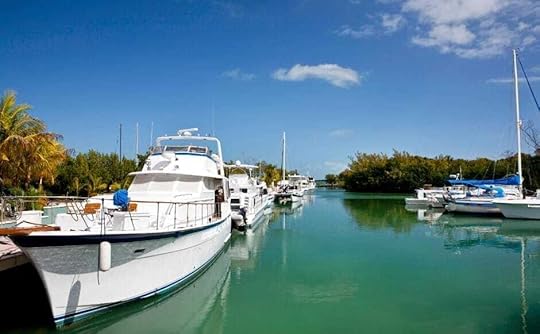 Explore the marina and the town most photogenic landmarks
Explore the marina and the town most photogenic landmarks8. The Bar Scene and Local Cuisine: Key Largo’s bar scene often means live music and the culinary scene is a delightful fusion of fresh seafood and Caribbean flavours. Be sure to try local specialties on the menu such as conch fritters, stone crab, and Key lime pie. Many Key Largo bars and restaurants on the water offer stunning sunset views.
Snook’s Bayside Restaurant & Grand Tiki Bar offers live music, happy hour and sunsets. Jimmy Johnsons Big Chill is the winner of the Key Largo Cook Off and so a great place to eat burgers, steaks, and seafood, while your enjoying your famous sunsets.
Another restaurant that has featured on TV and Food Network is Key Largo Conch House Restaurant & Coffee Bar specialising in fresh seafood and local produce. We particularly enjoyed Sharkey’s Sharkbite Grill on Caribbean Drive for food and music and a great atmosphere. Checkout more places to eat and drink in Key Largo.
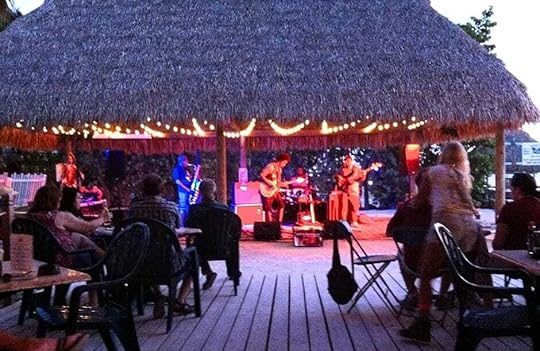 Key Largo’s bar scene often means live music
Key Largo’s bar scene often means live music 9. Go Fishing: Take a private fishing trip and your host will provide everything you need to get you started regarding all permits, fishing equipment, bait, tackle, snorkel gear, sandwiches, drinks, towels and will even offer to fillet and store your catch. Your experience can be customised, so if you want to fish, snorkel or just hang out, plan the day however you like.
Find out more Key Largo Fishing Charters.
10. Kayak Eco Tour: Paddle through the mangrove ecosystem of Tavernier Creek on a single or double kayak on this guided tour. Paddle to nearby mangroves, deserted islands, or a hidden lagoon. Ideal for first-time paddlers, glide in shallow, clear water over sponges, grass beds, and sandy patches. Marine life like turtles, stingrays, dolphins, and manatees can sometimes be spotted nearby.
Find out about Key Largo Eco Boat Trip.
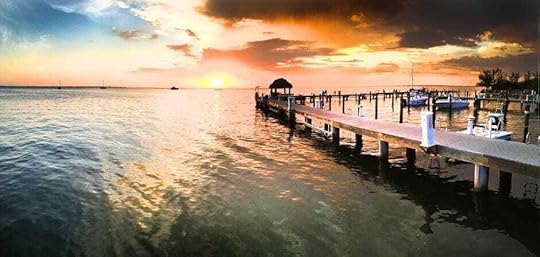 Key Largo is world famous for sunsets
BEST TIME TO VISIT
Key Largo is world famous for sunsets
BEST TIME TO VISIT
Best Overall Time: December to May: This is dry season with warm weather (70s–80s °F), low humidity, and minimal rain. A perfect time for snorkelling, diving, boating, and beach lounging. The downside is that it’s peak tourist season so expect higher prices and more crowds especially around holidays. We travelled at the end of May just after Memorial Weekend.
Best for Fewer Crowds & Deals: September to November: This is the tail end of hurricane season so prices drop and the crowds thin out. The weather is still warm but there’s a higher chance of rain or storms. I recommend you get travel insurance just in case and watch the weather forecasts closely.
Best for Diving & Snorkelling: June to August: The summer months bring calm clear waters with excellent visibility. You’ll see tons of marine life. It’s hot and humid. Also, be aware, it’s the beginning of hurricane season.
Key LargoBest TimeGreat WeatherDec–MayFewer CrowdsSept–NovBest Water VisibilityJune–AugBudget TravelSept–Nov DISCOVER THE MAGIC OF KEY LARGOKey Largo is a destination that captivates its visitors with its natural beauty, cultural heritage, and so many opportunities for discovering Key Largo’s fun and adventure and relaxation.
Whether you’re exploring vibrant coral reefs, savouring local delicacies, taking a boat trip, or simply basking in the sun on a pristine beach or at your resort hotel, the island offers you a unique and unforgettable experience.
I hope this post has inspired you as you plan your trip so you can consider what aspects of Key Largo will interest and excite you the most. How will you make the most of your time in the best of Key Largo?
 The Backpacking Husband was excited to explore Divers Direct in Key Largo!
The Backpacking Husband was excited to explore Divers Direct in Key Largo!RECOMMENDED READING
Read about my experiences travelling from Key Largo to Key West and the best things to do in Key West!
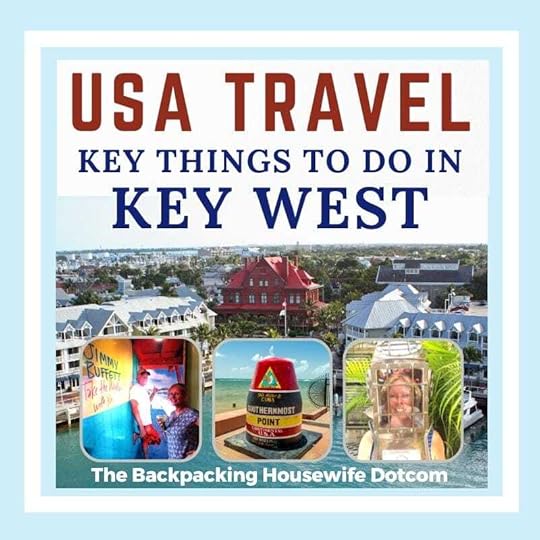

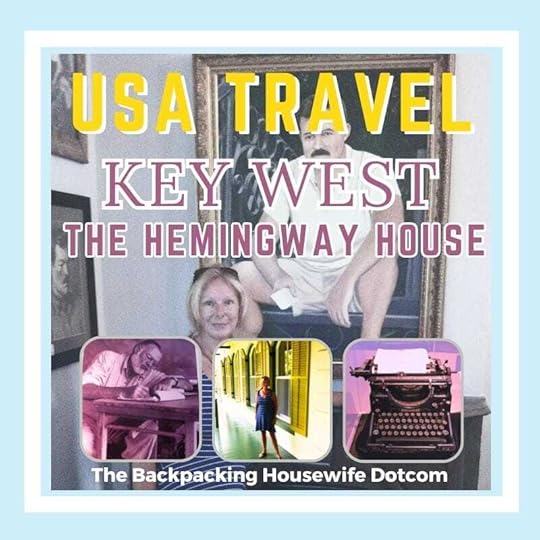
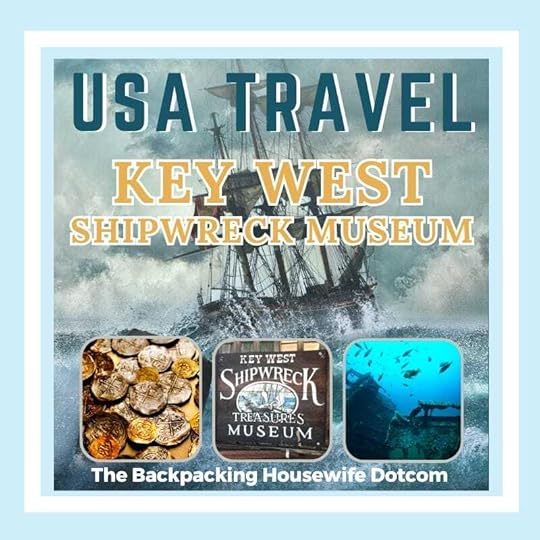
THE BACKPACKING HOUSEWIFE RECOMMENDS TRAVEL INSURANCE

The post Discovering Key Largo appeared first on The Backpacking Housewife.
April 6, 2025
Heartbroken…
My heart is broken into a million pieces and it hurts so much to share with you that my love, my wonderful, kind, generous, and beloved backpacking husband of 41+ years, my soul mate and father to our three amazing boys and our three beautiful grandchildren, has passed away. James (also known to many as Trav) died in my arms during the early hours of 6th March.
To our shock, with just one minor niggling medical concern apparent, he was diagnosed with stage 4 bowel cancer early last year, in 2024. He decided he wanted to keep this news within our family circle while he determinedly went through palliative chemo treatment. Family have been so loving and amazingly supportive over what has been a year of extreme highs and terrible lows. We all love him dearly and I know everyone he met him also loved him.
The messages of love and condolences I’ve received have been heart warming but as you might imagine I will never get over losing him – the love of my life.
The reason I’m writing this ever-so personal post is that I have a story I want to tell you and an important message I feel strongly about sharing. It’s about living the life of your dreams – making your own ‘One Day’ into ‘Day One’. Because time might be shorter than you think.
It concerns me that with the state pension age ever rising, more and more people are putting off leaving the workplace. Last month, troubling statistics found more women than ever are working past the age of sixty five.
The story that follows isn’t fiction. It’s heartbreakingly real.
So, if you’re planning to retire early but you’re not sure you dare?
You should read on…
 Make your ‘One Day’ into ‘Day One’ because time might be shorter than you thinkPlanning to retire early but not sure you dare?
Make your ‘One Day’ into ‘Day One’ because time might be shorter than you thinkPlanning to retire early but not sure you dare?Last November, my husband James celebrated his 65th birthday. For many, this is the age you can stop working and finally start living your dreams, the long, retirement years stretching ahead of you.
Certainly, for a long time, that’s what James and I thought this milestone birthday would mark for us.
Instead, he spent the day having palliative chemotherapy after being diagnosed with stage 4 bowel cancer eight months earlier. He died three weeks ago – exactly a year after being diagnosed.
After a 41-year marriage, it doesn’t feel real that James will never again stand by my side. But in the depths of my grief, there is one thing that I’m thankful for.
Because, 11 years ago, James and I faced a monumental dilemma. Both 54, with a severe case of empty nest syndrome and a desire to travel the world, we asked ourselves if we should postpone our dreams for another decade until the mortgage was paid off and we could retire with financial security – or take the gamble of our lives, sell everything we owned and indulge our wanderlust right away?
 Both 54, with a severe case of empty nest syndrome and a desire to travel the world
Both 54, with a severe case of empty nest syndrome and a desire to travel the worldWe agonised over the decision, wondering if we’d be fools to take such a risk, knowing it would mean we’d probably never own a home again and would end up renting in our old age.
But eventually we decided to take the gamble and retire early. It means we spent the ten years before James’s diagnosis travelling the world and living our dreams.
The reality if we hadn’t taken that path, and instead hung fire for the security of a pension? Well, James would have died before he could retire.
With the state pension age ever rising, more and more people are putting off leaving the workplace. Last month troubling statistics found more women than ever are working past 65.
But to anyone wrestling with the decision over whether to retire early or stick it out a few more years – let our story be a warning.
 We spent the ten years before James’s diagnosis travelling the world and living our dreamsOUR LOVE STORY
We spent the ten years before James’s diagnosis travelling the world and living our dreamsOUR LOVE STORYJames and I met in 1981 when we were both 21, marrying two years later. We moved from Cheshire to Scotland and our three sons – Ben, James and Iain, now in their 30s – were born in quick succession. James built an engineering business, while I was a full-time mum and helped with the business admin.
Travel was a cornerstone of our family life. We’d take the boys away once a year, always saving up for the next trip.
James and I fantasised about a time when we could give up work, sell the business and travel the world. But we had resigned ourselves to this being decades away.
That is until we found ourselves suddenly bereft after the boys all flew the nest. Without the happy chaos of family life, our rural cottage no longer felt like home. Their three empty bedrooms filled me with sadness and the huge garden that had once given us such joy felt like a burden to maintain. I lacked purpose.
We began to question what was next for us, now we were no longer just mum and dad.
That’s when the idea of giving it all up to go travelling and retire early began to take hold. If we sold everything, paying off our mortgage, we’d have the funds to do it.
We didn’t know anyone else who’d decided to retire early – let alone in such dramatic fashion. But once we’d made up our minds, there was no going back.
By autumn 2012 we’d decided to liquidate all our assets: the cottage, the business, both cars and all our possessions. After a year on the market, the house finally sold in October 2013.
We had one last magical Christmas there with the boys before we moved out in January 2014.
We wanted to leave room for spontaneity, to experience real freedom, so we didn’t have a concrete plan of where we’d go or even exactly how long we might travel. We just wanted to do it while we were still young enough to still enjoy it, and were confident we could finance our travels with money raised from selling our assets and careful budgeting. In fact. Life abroad is often cheaper than in the UK.
We’d planned that James would take a small percentage of his private pensions when he turned 60. And we aimed to continue earning while we travelled by fulfilling our personal ambitions – me to start writing the novel I’d long dreamed of, James to pursue his love of scuba diving.
Our sons were fully supportive, as were friends – though when they threw a goodbye party for us, many joked that we must be having a midlife crisis to make such a mad, if brave, move.
Still, when James and I boarded that first flight to Barbados in February 2014, I was full of trepidation. Had we done the right thing? What if it didn’t work out? We didn’t even have a home to return to if it all went wrong.
But any nerves were quickly soothed as we hopped around the Caribbean islands. Life felt incredibly exciting; meeting interesting people, trying new foods, staying in remote locations where even the power supply was unreliable. It was a world away from the daily grind our friends were living back home.
We eventually settled on the tiny island Utila, just off the coast of Honduras, for six months, where James gained all his PADI scuba diving instructor qualifications.
 We were so deliriously happy in our transient lifestyle we didn’t ever want it to end
We were so deliriously happy in our transient lifestyle we didn’t ever want it to end 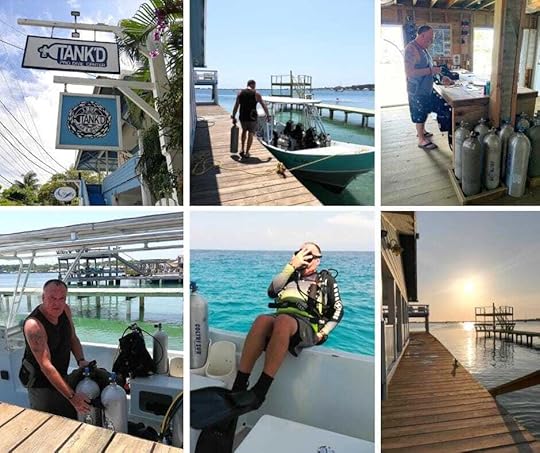 Utila, just off the coast of Honduras, where James gained scuba diving qualifications.
Utila, just off the coast of Honduras, where James gained scuba diving qualifications.Our next stop was Asia, where I penned a draft for my first novel, The Backpacking Housewife. To my deep joy, I landed a three-book deal and James suggested we could look into house-sitting so I had a comfortable base to write. That’s how we ended up in a magnificent chateau in the Dordogne for six months.
What followed was another nine years of pinch-me moments.
Circumnavigating the world twice over, we visited 65 countries. We saw the Grand Canyon, wild orangutans in Borneo and had a picnic at the top of Mount Misin in Japan, where an eternal flame has been burning for 1,200 years, to name a few. We even renewed our vows in Vegas with Elvis just for the fun of it.
James used his new diving skills to take part in dream experiences such as working on a major archaeological dive on a 17th century shipwreck in the Caribbean, while I worked on my travel website. Occasionally we’d return to the UK to visit family and friends, including a forced return for the lockdowns in 2020 and 2021, when we rented until restrictions were lifted.
Whenever challenges arose, we’d pull together to solve them. We were naturally frugal, but never to the point we went without. In fact, we felt incredibly rich, so deliriously happy in our transient lifestyle that we didn’t ever want it to end.
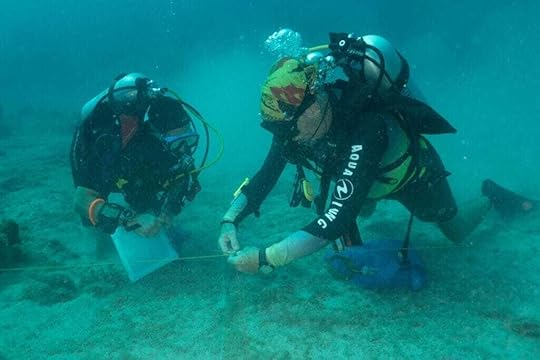 James used his diving skills to work on a major archaeological dive on a 17th century shipwreck in the CaribbeanSHOCK DIAGNOSIS
James used his diving skills to work on a major archaeological dive on a 17th century shipwreck in the CaribbeanSHOCK DIAGNOSISIn February last year, we paused our travels and temporarily rented a house in Shropshire to be close to my elderly mum after she was recovering from a stroke.
We hoped to resume our adventures later in the year. But not long after we arrived back in the UK, James started complaining of a niggling discomfort, which he suspected could be haemorrhoids.
If only it had been something so routine.
 We spent the ten years before James’s diagnosis travelling the world and living our dreamsHEARTBROKEN
We spent the ten years before James’s diagnosis travelling the world and living our dreamsHEARTBROKENAfter a visit to the GP, he was immediately sent for a scan, then a colonoscopy. Days later, in March 2024, we received the news that he had terminal bowel cancer that had spread to his liver and lungs. It was heart-breaking.
James had surgery and began palliative chemotherapy. Designed to extend his life, the treatment was gruelling and relentless. But he maintained a positive attitude and his body responded well.
We were able to enjoy sitting in our small garden at the Shropshire house and occasionally manage short walks. But as the summer drew to a close, I could see he was getting weaker.
It was like living in a nightmare. I was going to lose my lovely, kind and adventurous husband and I couldn’t bear to think of a future without him.
During his final months, we reflected on how incredibly grateful we were that we’d taken that big risk and realised so many of our dreams.
Now, rather than knowing we spent the last decade of James’s life with him working all hours and me holed up at home doing admin and missing our boys, I have 11 years of wonderful memories to look back on. And though I’m currently too numb to contemplate the future and need the comfort of family around me, I made him a promise that I’ll go on and have more adventures as a solo traveller and he will always be with me in my heart.
And, in the meantime, I will continue to write here on my website about travel adventures I’ve still to tell you about and then I’m sure I’ll have new ones to share too. I’d love your support during this time and would appreciate you sticking with me and if you’d like to receive my monthly newsletters please do to consider subscribing to my mailing list.
 During James’s final months, we reflected on how grateful we were that we had realised so many of our dreams
During James’s final months, we reflected on how grateful we were that we had realised so many of our dreamsSo, to anyone conflicted over whether it’s time to leave their working life behind, I say, just do it. You don’t have to sell your home to retire early and go off like vagabonds as we did.
You could take a sabbatical and rent your property while you travel, enquire about housesitting or simply increase the number of short breaks you take.
But whether it’s a holiday, yoga retreat or just the prospect of being able to call your time your own again that’s calling you, scrutinise your finances and lifestyle and find a way to make it happen. Don’t spend your life putting it off until ‘someday’.
As I know only too well, tomorrow isn’t promised.

Are you considering an early retirement?
What would it take for you to retire early?
Would you be prepared to downscale in order to follow your dreams and achieve your personal ambitions?
Would you be prepared to risk a less financially secure old age in the future?
Do leave a comment below or contact me privately.
I promise to reply.
Janice xx
This article appeared in the UK’s Daily Mail newspaper and The Mail Online (April 4th 2025)
As told to Sadie Nicholas
THIS IS THE LINK TO READ THIS MAIL ONLINE FEATURE

I was delighted that lots of people commented online in response to the feature and that it instigated an interesting debate on travel and retirement. Many heartbroken souls sent me direct messages telling me their own stories.
Many were in a similar situation to me and thankful to have had prioritised personal time before it was too late.
Others told me they had lost their loved ones before they could enjoy retirement and had regrets.
A few reticent ones told me that taking such a big risk in selling everything and retire early to travel was foolhardy.
What’s your opinion on that?

The post Heartbroken… appeared first on The Backpacking Housewife.
April 2, 2025
Secrets of Key West Shipwreck Museum
Ahoy there! If you ever find yourself on the sun-drenched shores of Key West Florida looking for interesting and key places to visit then a really great place to explore is the Key West Shipwreck Museum.
It’s a living history museum and a recreation of a 19th-century wrecker’s warehouse now housing artifacts recovered from old shipwrecks, including the cursed treasure from Spanish galleon Nuestra Senora de la Maravillas that was wrecked off Key West in 1656, and the notorious Isaac Allerton that sank with its cargo of riches in 1856.
The Key West Shipwreck Museum does more than just showcase maritime history, as the relics and artifacts on display offer you a fascinating and tangible connection to the past, and a fascinating insight into the world of shipwrecks and salvage.
The displays are carefully curated and offer a dynamic interactive experience, with costumed actors and multimedia presentations, to whisk you back in time to the thrilling world of daring 19th-century wrecking when the sea was both a perilous adversary and a lucrative treasure trove.
So, dive in with me as we explore together the secrets of the Key West Shipwreck Museum where we’ll uncover a fascinating history, hear brave and adventurous stories of wreckers, and see for ourselves all the fabulous salvaged treasures on display!
 A really great place to explore is the Key West Shipwreck Museum
A really great place to explore is the Key West Shipwreck MuseumTABLE OF CONTENTS
SECRETS OF KEY WEST SHIPWRECK MUSEUMIMMERSIVE STORYTELLINGWHERE TO STAY IN KEY WESTHISTORY OF WRECKERS AND SHIPWRECKS IN KEY WESTTHE LOOKOUT TOWERTREASURES AWAITS AT THE SHIPWRECK MUSEUMTHE FASCINATING TALE OF THE ISAAC ALLERTONSHIPWRECKS AND SUNKEN TREASURETHE CURSED TREASURE FROM THE NUESTRA SENORA DE LA MARAVILLASPLAN YOUR VISIT A fascinating insight into the world of shipwrecks and salvage
IMMERSIVE STORYTELLING
A fascinating insight into the world of shipwrecks and salvage
IMMERSIVE STORYTELLING
The museum’s storytelling approach is both educational and entertaining. Through reenactments and presentations, you’ll feel as though you’re living the history rather than just learning about it.
Young explorers will find themselves captivated by the interactive exhibits and engaging stories. It’s a perfect destination for families looking to blend education with adventure.
I found the replica of the wrecker’s warehouse excitingly atmospheric inside and I really enjoyed viewing all the old diving equipment and salvaged treasures on display. It certainly helped me to gain a deeper understanding of Key West’s unique maritime heritage and how the wrecker industry had shaped the island’s history and founded its swashbuckling reputation.

 WHERE TO STAY IN KEY WEST
WHERE TO STAY IN KEY WEST
We’d arrived in Key West at the end of May and we were celebrating our wedding anniversary. So we decided to book in a very nice room at the historic boutique Lighthouse Hotel just a ‘mango throw’ away from the Historic District and Duval Street and a short walk to The Key West Shipwreck Museum (0.7 miles or 1.12 km).
Our accommodation was a small and beautifully appointed cottage with a patio out front and just across the street from The Hemingway House!
As there are so many places to stay in Key West and in the Florida Keys from big-name resort hotels, smaller motels and private guesthouses.
I would advise you to always book ahead – especially during the holidays – and I recommend the best way would be using an online booking site to immediately confirm your accommodation.
While organising your accomodation why not grab your tickets for The Key West Shipwreck Museum at the same time?
Our stay at The Lighthouse Hotel was wonderful.
FIND YOUR PERFECT PLACE TO STAY IN KEY WEST USING THIS INTERACTIVE MAP
HISTORY OF WRECKERS AND SHIPWRECKS IN KEY WESTDuring the 19th century, the treacherous reefs surrounding the island claimed numerous ships. Back then, records show that at least one ship a week out of the hundred or so that would sail past Key West would find itself wrecked on the treacherous reef.
Notoriously, the waters off Key West were some of the most perilous waters in the world, due to bad weather, strong currents, and even hurricanes and while this was disastrous for the ships’ owners, it was a golden opportunity for Key West residents.
Wreckers were salvagers who braved the seas to rescue crews and recover cargo from shipwrecks. They weren’t pirates because it was a legal and highly profitable business. The wreckers operated under strict maritime laws, requiring them to save lives first and then salvage goods. This legal framework turned potential disasters into thriving business ventures.
The shipwreck salvaging industry had a profound impact on the economy and development of Key West, contributing to its prosperity and cultural richness.
Wrecking made Key West one of the richest cities in the United States by the mid-1800s.
Klook.com (function (d, sc, u) { var s = d.createElement(sc), p = d.getElementsByTagName(sc)[0]; s.type = "text/javascript"; s.async = true; s.src = u; p.parentNode.insertBefore(s, p); })( document, "script", "https://affiliate.klook.com/widget/fe..." );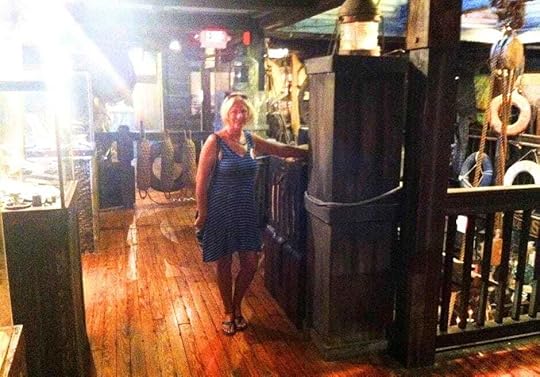 The replica of the wrecker’s warehouse is excitingly atmospheric inside
THE LOOKOUT TOWER
The replica of the wrecker’s warehouse is excitingly atmospheric inside
THE LOOKOUT TOWER
One of the highlights of the museum is the 65-foot lookout tower. This is a replica of the towers used by 19th-century wreckers to scan the horizon for ships in distress.
A climb to the top will reward you with a breathtaking panoramic view of Key West and the wooden structure creaks as you climb, giving it an authentic, old-world feel.

 A breathtaking panoramic view of Key West Klook.com (function (d, sc, u) { var s = d.createElement(sc), p = d.getElementsByTagName(sc)[0]; s.type = "text/javascript"; s.async = true; s.src = u; p.parentNode.insertBefore(s, p); })( document, "script", "https://affiliate.klook.com/widget/fe..." );
TREASURES AWAITS AT THE SHIPWRECK MUSEUM
A breathtaking panoramic view of Key West Klook.com (function (d, sc, u) { var s = d.createElement(sc), p = d.getElementsByTagName(sc)[0]; s.type = "text/javascript"; s.async = true; s.src = u; p.parentNode.insertBefore(s, p); })( document, "script", "https://affiliate.klook.com/widget/fe..." );
TREASURES AWAITS AT THE SHIPWRECK MUSEUM
What treasures can you expect to see when you step inside the Key West Shipwreck Museum?
Well, there’s lots of authentic artifacts from shipwrecks, including china, coins, and navigational instruments, plus fascinating documents and maps that chart the maritime history of the surrounding waters.
The museum places special emphasis on the Isaac Allerton, one of the most profitable wrecks in Key West history. You can view the relics and treasures recovered from this ship and learn about its dramatic demise.
I found the story of the Isaac Allerton particularly fascinating.
 The Isaac Allerton is one of the most profitable wrecks in Key West history
THE FASCINATING TALE OF THE ISAAC ALLERTON
The Isaac Allerton is one of the most profitable wrecks in Key West history
THE FASCINATING TALE OF THE ISAAC ALLERTON
The story of the Isaac Allerton is one of the most famous shipwrecks in Key West history. The Isaac Allerton was a three-masted schooner, a type of ship known for its speed and agility. Built in 1878, this sturdy vessel was named after Isaac Allerton, a Pilgrim who sailed on the Mayflower.
The schooner was primarily used for transporting a valuable cargo goods between the Caribbean and the United States, carrying everything from sugar and tobacco and molasses to rum and other commodities.
The Isaac Allerton’s demise begins on August 28, 1888. On a seemingly ordinary day, the schooner set sail from Havana, Cuba, loaded with cargo and a small crew.
The journey to New York was expected to be routine. However, as the ship navigated the waters off Key West, it encountered a powerful hurricane and the Isaac Allerton was tossed onto the treacherous coral reefs off Saddlebunch Keys, 15 miles east-southeast of Key West, and sank in five fathoms of water.
In the wake of the shipwreck, the community of Key West sprang into action. They managed to save the crew of the Isaac Allerton, but the ship itself was beyond repair.
The wreckers salvaged what they could and their efforts yielded a pay out of over $50,000 which made it one of the most valuable salvage jobs of that period.
 The wreckers efforts yielded a pay out of over $50,000Klook.com (function (d, sc, u) { var s = d.createElement(sc), p = d.getElementsByTagName(sc)[0]; s.type = "text/javascript"; s.async = true; s.src = u; p.parentNode.insertBefore(s, p); })( document, "script", "https://affiliate.klook.com/widget/fe..." );
The wreckers efforts yielded a pay out of over $50,000Klook.com (function (d, sc, u) { var s = d.createElement(sc), p = d.getElementsByTagName(sc)[0]; s.type = "text/javascript"; s.async = true; s.src = u; p.parentNode.insertBefore(s, p); })( document, "script", "https://affiliate.klook.com/widget/fe..." );But the story did not end there because the shipwreck became an integral part of Key West’s rich maritime history, serving as a reminder of the dangers faced by seafarers of the past.
Today, the wreck of the Isaac Allerton is one of the most well-preserved shipwreck sites in Florida’s waters. It offers a unique glimpse into the past with its coral-encrusted remains serving as a time capsule from the 19th century.
The wreck is accessible to divers and snorkelers and a visit to its underwater resting place is a must for those intrigued by the story of the Isaac Allerton. Before diving, however, it’s important to remember that shipwrecks are protected sites
Divers should respect the historical significance of these underwater museums and refrain from disturbing or removing any artifacts. By preserving these sites, we ensure that future generations can also experience the wonder of exploring a piece of history.
 The Backpacking Husband works on a shipwreck salvage site
SHIPWRECKS AND SUNKEN TREASURE
The Backpacking Husband works on a shipwreck salvage site
SHIPWRECKS AND SUNKEN TREASURE
I love a good treasure hunting story especially if it involves shipwrecks and sunken treasure. Quite recently, my backpacking husband, who is a highly qualified scuba diver, was involved with an exciting archaeological project to salvage an unknown 17th century shipwreck discovered on the Meso-American Reef in the Caribbean.
He was one of the safety drivers on the salvage operation who monitored the conditions on the site and the divers – archaeologists and marine biologists – working on the dive site. Every evening I would press him to tell me all the exciting events of the day. To me it was all very adventurous and much like one of my favourite movies ‘Fool’s Gold’.
So, at Key West Shipwreck Museum, I was further captivated with the story of the cursed treasure from the Spanish galleon Nuestra Senora de la Maravillas which sank carrying a vast amount of gold, silver, and emeralds, to Seville Spain in 1656!
 Cob coins were cut from a silver bar and struck with a royal insignia
THE CURSED TREASURE FROM THE NUESTRA SENORA DE LA MARAVILLAS
Cob coins were cut from a silver bar and struck with a royal insignia
THE CURSED TREASURE FROM THE NUESTRA SENORA DE LA MARAVILLAS
On the 4th January in 1656, the Spanish galleon Nuestra Senora de la Maravillas, which was two decks high and was armed with 36 bronze cannons and loaded with over five million pesos in gold, silver, and emeralds collided with another ship in her flotilla during a storm near Grand Bahama.
Having sustained serious damage to the ship’s hull, the captain attempted to ground the vessel on a reef near Little Bahama Bank. High winds and rough seas battered the disabled vessel against the rocks until it broke apart. Of the 650 men aboard only 45 survived the catastrophic wreck.
Salvage of the lost treasure was initiated almost immediately as six frigates were dispatched from nearby Havana. The salvage vessel Madama do Brasil sank carrying a huge load of recovered coins in June of 1657 when her hull broke as a storm drove her into the reef off Gordo Cay. The salvage effort went on for over four years, during which time four of the six frigates involved in the operation sank carrying the Nuestra Senora de la Maravillas ill-fated fortune.
Much of the treasure retrieved early in the salvage effort was lost again when an entire Spanish fleet transporting the recovered riches to Spain was destroyed by British privateers near the Canary Islands in late 1657. Legends of a curse surrounding the treasure grew, as much of the silver aboard Maravillas had originally been salvaged from the wreck of the Jesus Maria de la Limpia Concepcion which sank off the coast of present-day Ecuador in 1654.
The Spanish salvors were unable to locate the main portion of the Maravillas and retrieved only a fraction of the lost treasure. Operations were suspended for over a decade until 1677 when a new salvage yielded an additional two tons of silver. The wreck site was then abandoned for nearly three centuries until it was rediscovered by Robert Marx in 1972.
Marx, a seasoned treasure-hunting veteran who has researched the Maravillas for years, quickly located the ship and began to retrieve large quantities of coins and other artifacts. Unfortunately Marx soon found himself entangled in a lengthy and expensive court battle with the Bahamian government. After being forced to surrender much of his findings, he was forbidden to continue the salvage of the wreck.
In 1986 a new salvage expedition was launched by Herbert Humphreys Jr. and the Marex Corporation through an agreement with the Bahamian authorities. Over the next few years Humphreys and his crew retrieved treasure from the site ranging from gilded weapons and exquisite jewellery to gold bars and uncut emeralds. While their expedition was unquestionably successful, they were unable to locate the missing main portion of the ship and the mother-load of the Maravillas treasure.
Treasure hunters continue to search for the undiscovered cache to this day, though the Bahamian government has not officially granted salvage rights to the wreck since the early 1990’s.
Bahamas Maritime Museum was created to hold the salvaged treasure of the Maravillas in an exhibition to display and share these wonderful salvaged treasures and artifacts with the public.
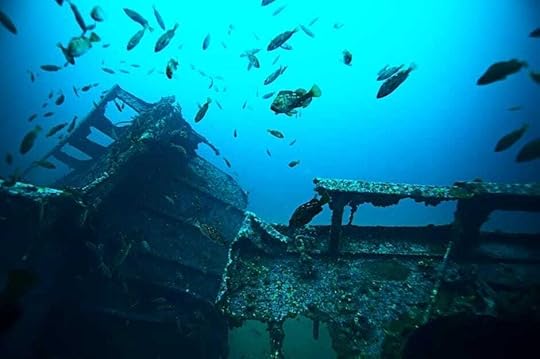 The salvage vessel Madama do Brasil sank carrying a huge load of coins in June of 1657
PLAN YOUR VISIT
The salvage vessel Madama do Brasil sank carrying a huge load of coins in June of 1657
PLAN YOUR VISIT
The Key West Shipwreck Museum offers more than just a glimpse into the past; it provides an exhilarating journey through time. From the daring exploits of the wreckers to the treasures recovered from the deep, this museum is a treasure chest of history waiting to be unlocked.
Whether you’re a history buff, adventure seeker, or just looking for a unique experience in Key West, the Shipwreck Museum promises a voyage you won’t soon forget.
Check the museum’s operating hours and consider visiting during off-peak times to avoid crowds.
Find out more and how to get tickets for the Shipwreck Museum.
Don’t miss the interactive exhibits and live presentations as they’re an integral part of the museum experience.
 Having fun at The Key West Shipwreck Museum
Having fun at The Key West Shipwreck Museum Are you ready to set sail into the captivating world of shipwrecks and salvage?
In Key West explore The Shipwreck Museum and discover the secrets it holds!
I RECOMMEND BUYING YOUR TICKETS ONLINE FROM KLOOK
Klook.com (function (d, sc, u) { var s = d.createElement(sc), p = d.getElementsByTagName(sc)[0]; s.type = "text/javascript"; s.async = true; s.src = u; p.parentNode.insertBefore(s, p); })( document, "script", "https://affiliate.klook.com/widget/fe..." );FIND MORE KEY PLACES TO VISIT IN KEY WEST

The post Secrets of Key West Shipwreck Museum appeared first on The Backpacking Housewife.



